10–29 JULY 2023
By Dominic Rollinson
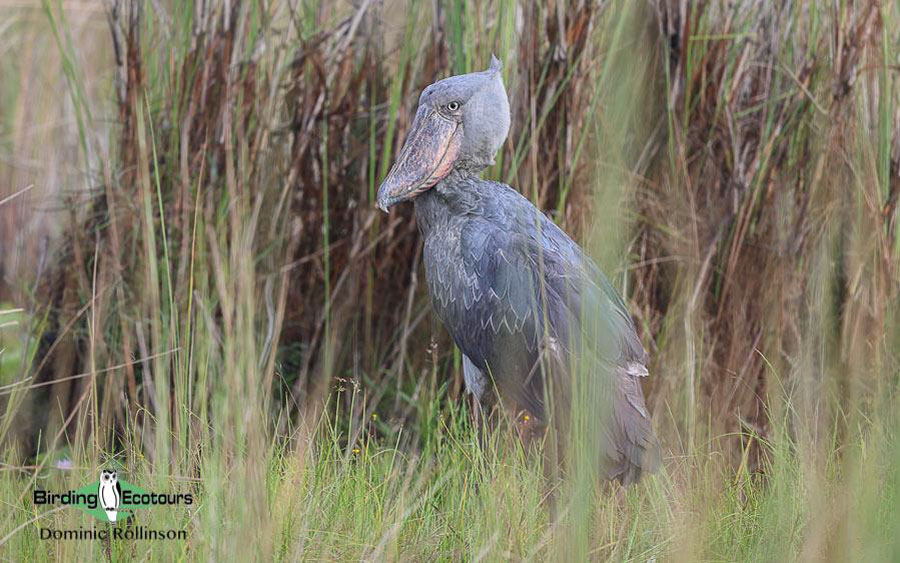
Shoebill was an early trip highlight and perhaps our most-wanted Ugandan bird target.
Overview
Our fixed departure Uganda birding tours offer you the opportunity of seeing a vast selection of East African bird species, including a whole host of Albertine Rift endemics, as well as many well-known and charismatic mammal species. Uganda is known amongst birders as perhaps the most accessible country to find two iconic bird species; the massive and bizarre-looking Shoebill and the enigmatic Green-breasted Pitta, both of which were seen well on this tour. Our 19-day Uganda birding tour covers the ‘traditional’ birding route through the western half of the country and adds on some lesser-visited spots, such as Mgahinga Gorilla National Park, right in the southwestern corner of Uganda, on the border with Rwanda and the Democratic Republic of Congo (DRC). This tour was scheduled during Uganda’s dry season, when inclement weather generally does not play a role, and to coincide with the peak breeding season of many of our special targets.
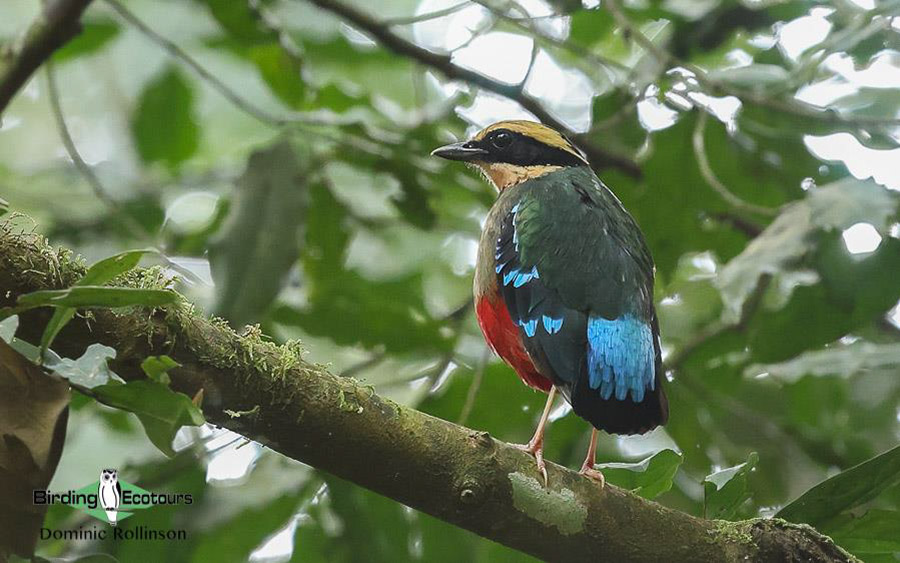
Green-breasted Pitta put on an exceptional show for us at Kibale Forest.
Despite this being our set departure tour, we were able to run it with just two clients, David and Barbara, which meant it could essentially be run as a private tour, occasionally opting out of certain strenuous hikes etc. This meant we missed a few Albertine Rift Endemics and other specials by excluding the Mubwindi Swamp walk, however, the birding was exceptional throughout the trip, and we amassed a list of 534 species.
This tour started in Entebbe, before we moved to the shores of Lake Victoria at Mabamba Swamp, where we had special views of the most-wanted bird of the trip, Shoebill. We then pressed on southwest to Lake Mburo National Park, where we spent two days birding the dry woodlands, with highlights including Red-faced Barbet, and enjoyed a boat cruise on Lake Mburo, which saw us adding African Finfoot and White-backed Night Heron. Next, was a long transit to the southwest corner of the country, where we had a full day’s birding in the Mgahinga Gorilla National Park and found our two main targets of the area; Rwenzori Turaco and Rwenzori Double-collared Sunbird, as well as a pair of the tricky White-collared Oliveback.
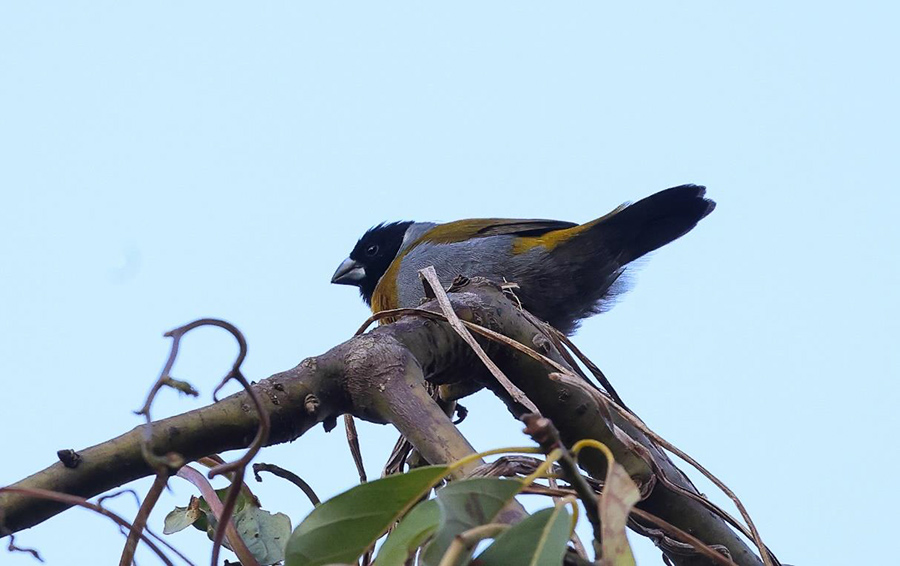
This male White-collared Oliveback was seen in Kisoro.
The famous Bwindi Impenetrable Forest was up next, where we spent five nights and enjoyed a lot of forest birding and, of course, Eastern (Mountain) Gorillas. The highlands of the Ruhija section were particularly birdy, and we found such targets as Dusky Crimsonwing, Grauer’s Warbler and Stripe-breasted Tit. We spent a few hours birding The Neck en route to the lower forests of Buhoma, which added Bar-tailed Trogon and many other new bird species, before we spent three nights birding at Buhoma. Barbara had a fantastic experience on her gorilla trekking, and the general forest birding was again excellent, with a whole host of forest species enjoyed here.
We then briefly left the Ugandan forests behind for a couple of days, birding the savannas and river channels of Queen Elizabeth National Park. This again resulted in a huge jump in our trip list, and we also enjoyed seeing Lion and Leopard while in the park.
It was soon back into the forests as we entered Kibale National Park, where we had a magical 20 minutes watching a displaying Green-breasted Pitta and bumped into some feeding Chimpanzees while enjoying the forest’s many bird specials.
After a long transfer further north, we spent the morning birding Budongo Forest’s famous Royal Mile. It was its usual birdy self with Fraser’s Forest Flycatcher, Chestnut-capped Flycatcher and African Dwarf and Chocolate-backed Kingfishers all seen well, with the neighboring farmlands producing Brown Twinspot and stunning views of Grey-headed Oliveback.
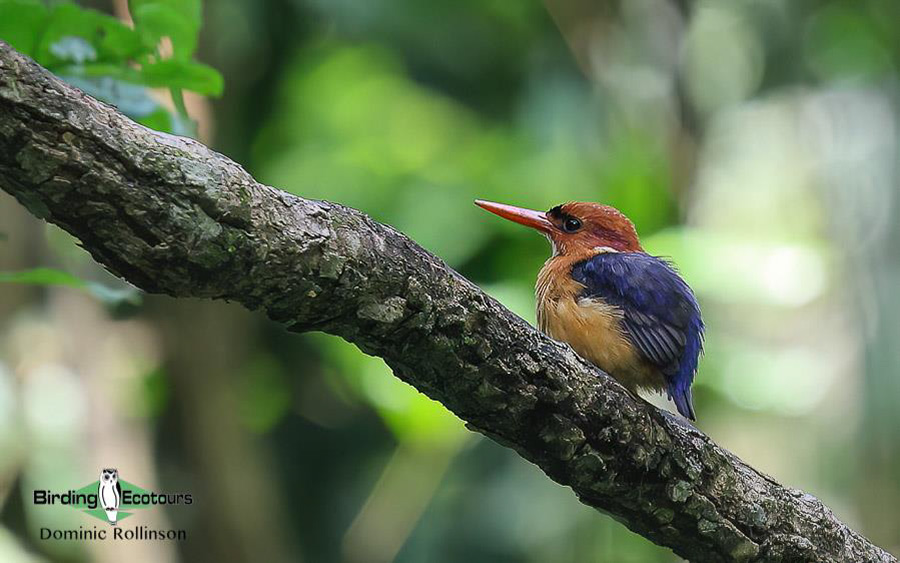
African Dwarf Kingfisher showed incredibly well in Budongo Forest.
Finally, we spent three nights in Murchison Falls National Park, where we saw a plethora of new wildlife and some standout species such as White-crested Turaco, Dusky Babbler and Pennant-winged Nightjar. It was then time to make our way back south towards Entebbe, with some final birding in Kaniyo Pabidi Forest and Ziwa Rhino Sanctuary before making our way back into Entebbe where the tour ended.
Detailed Report
Day 1, 11th July 2023. Entebbe birding
With all of us having arrived the afternoon before, we decided to get an early start to our birding with a walk around Entebbe’s very birdy suburbs and managed to find a heap of birds to get our Uganda bird list rolling. Some of the highlights of our pre-breakfast walk included African Hobby, Shikra, Ross’s Turaco, Eastern Plantain-eater, Crowned and Black-and-white-casqued Hornbills, Woodland Kingfisher, Broad-billed Roller, Grey Parrot, Black-headed Gonolek, Green-headed and Red-chested Sunbirds and a small group of Piapiacs. As we were enjoying breakfast, David spotted a pair of Palm-nut Vultures, which posed nicely for us.
After lunch, we met William, our driver and expert guide for the trip, and headed to the lovely Entebbe Botanical Garden on the shores of Lake Victoria, which always provides a fantastic start to our Uganda birding tour. Before reaching the botanical garden, we stopped at a nearby Bat Hawk roost, which was unfortunately empty, however, we did find a pair of roosting Southern White-faced Owls, which was an unexpected bonus. The botanical garden was alive with birds and we soon notched up Lizard Buzzard, Blue-spotted Wood Dove, the huge Great Blue Turaco, African Pygmy Kingfisher, Olive (Madagascar) Bee-eater, African Hobby, Grey Parrot, Green Crombec, Grey-capped Warbler, Winding Cisticola, Olive-bellied Sunbird and Orange and Golden-backed Weavers. After dipping on Bat Hawk earlier, we soon made up for this miss when we found a pair of roosting birds high up in the tree canopy. The lakeside was also full of birds, with Pink-backed Pelican, Hamerkop, Striated Heron and Pied Kingfisher all seen well. After an incredibly productive first day, with all our targets found, we enjoyed cold beers and a meal at our hotel before retiring for the evening, all excited about the prospect of Shoebills the next morning!
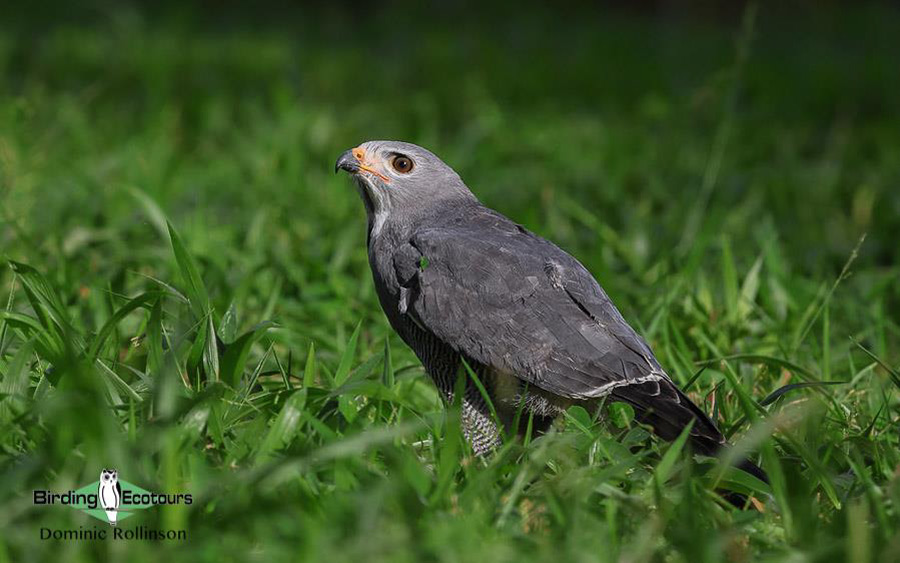
This confiding Lizard Buzzard was seen in the Entebbe Botanical Garden.
Day 2, 12th July 2023. Mabamba Swamp and transfer to Lake Mburo
An early start this morning as we made our way west towards Mabamba Swamp, where we would enjoy a boat trip to look for Shoebill. On our way out of Entebbe, David delighted in seeing Marabou Storks perched on top of buildings, immediately adding to the beauty of the building – beauty is in the eye of the beholder! We soon boarded our motorized dugout canoes and made our way through the swamp’s network of channels. It took a little while, but eventually, news filtered through that a Shoebill had been found nearby, and we shot by and were able to enjoy the bird for ten minutes all by ourselves before other tourist boats arrived on the scene, and it got a bit chaotic. David’s main target bird of the trip was in the bag on the first morning of the trip, with some fantastic views enjoyed by us all!
Of course, the general birding while out on the boat was productive too, and we also added the likes of Long-toed Lapwing, Blue-headed Coucal, African Swamphen, White-winged Tern, Purple and Squacco Herons, Great Egret, African Marsh Harrier, Blue-breasted Bee-eater, Banded and Brown-throated Martins, Red-breasted Swallow, Swamp Flycatcher and Northern Brown-throated Weaver. After our boat ride, we birded some woodland on the edge of the swamp, where we found African Blue Flycatcher, Brown-throated Wattle-eye, Copper Sunbird and Brimstone Canary.
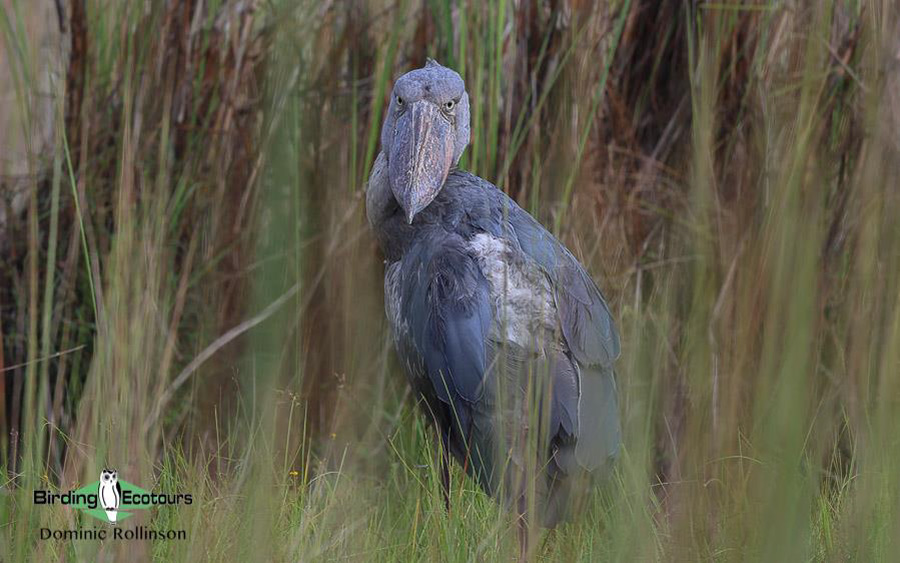
The huge and fierce-looking Shoebill was seen in Mabamba Swamp.
It was then time to get moving, as we still had some more birding to do before our lunch stop. We stopped on the edge of the nearby Mpanga Forestry Reserve, where we had flyover Palm-nut and Hooded Vultures and African Harrier-Hawk and were made to work for Weyn’s Weaver, which eventually showed, albeit briefly. Other birds seen in the area included African Pied and Crowned Hornbills, Black Cuckooshrike, Plain-backed Pipit and Tawny-flanked Prinia.
We stopped for a traditional lunch at the equator before the long haul southwest towards Lake Mburo National Park, where we would be based for the next two nights. The drive was mostly uneventful, however, we did add a few new trip birds, such as Lilac-breasted Roller, Long-crested Eagle, Speckled Pigeon and Black-chested Snake Eagle.
Late in the afternoon, we made it onto the dirt road to Lake Mburo, which is always incredibly birdy and thus normally takes a long time to negotiate. Today was no different, and we spent a good couple of hours working these farmlands and open woodlands. New birds came thick and fast and included the likes of Crested Francolin, Brown-chested Lapwing (one of the big targets of the area), Black-winged Kite, Blue-naped Mousebird, Little Bee-eater, Spot-flanked Barbet, Meyer’s Parrot, Grey (African) Penduline Tit, Red-faced Crombec, Trilling Cisticola, White-browed Scrub Robin, and a few cute Black-faced Waxbills. Verreaux’s Eagle-Owl, starting its night out a little early today, was a welcome surprise to cap off the day. We then settled into our lovely accommodation with Freckled Nightjar heard calling as we enjoyed a tasty dinner that evening.
Day 3, 13th July 2023. Lake Mburo National Park birding and boat cruise
After an early breakfast, we were in our land cruiser and on the way to Lake Mburo National Park, where we birded for the entire morning. The farmland and degraded woodland en route to the park was a little quieter than usual, however, we did manage to find Bare-faced Go-away-bird, White-browed Coucal, White-winged Black Tit, Long-tailed Cisticola, Arrow-marked and Black-lored Babblers and Marico Sunbird.
The entrance gate to Lake Mburo National Park was its usual birdy self, and we soon found our target bird, Red-faced Barbet, which was seemingly part of a mixed-species pair as it was displaying with the similar Black-collared Barbet. Other good birds seen here included Snowy-crowned Robin-Chat, Common Scimitarbill, Lesser Masked Weaver and Green-winged Pytilia, with Red-headed Lovebirds seen noisily flying overhead. We also enjoyed our first views of large game, including Plains Zebra, Common Warthog, African Buffalo, Bushbuck, Common Eland, Impala, Waterbuck, Topi and Giraffe.
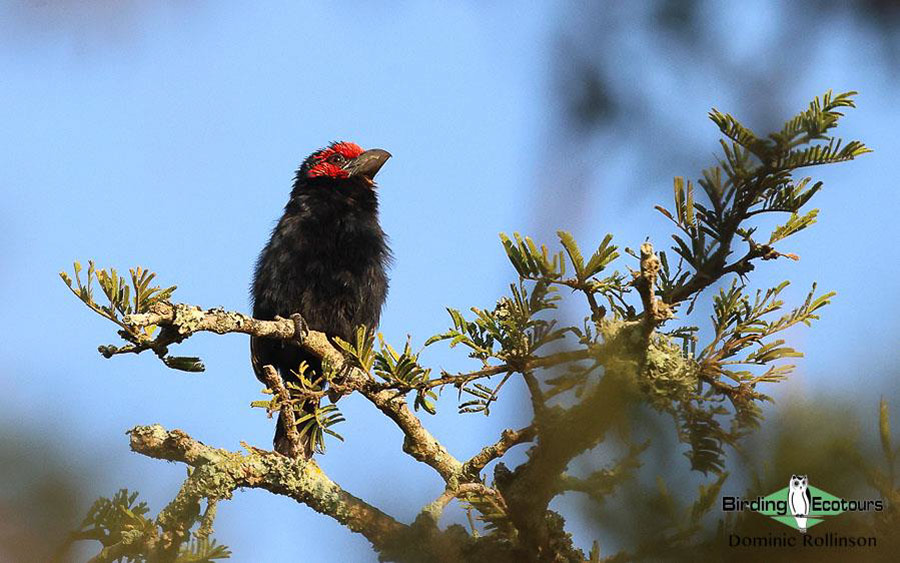
This Red-faced Barbet was seen at Lake Mburo National Park.
We then took a very slow drive through the productive woodlands where the birding was exceptional. We came across many feeding flocks, and slowly working through them gave us a multitude of new birds. Our long list of highlights from within Lake Mburo National Park included Red-chested Cuckoo, Green Wood Hoopoe, Grey-headed and Striped Kingfishers, Crested Barbet (a range-restricted species in southwestern Uganda), White-headed Barbet, Cardinal, African Grey and Nubian Woodpeckers, Meyer’s Parrot, Black Cuckooshrike, Chinspot Batis, Orange-breasted Bushshrike, White-winged Black Tit, Grey Penduline Tit, Red-faced Crombec, Green-capped Eremomela, Greater Blue-eared Starling and many others. Several raptor species were seen throughout the morning and included White-backed Vulture, Bateleur, Wahlberg’s Eagle and Grey Kestrel. We enjoyed watching a small group of Senegal Lapwings feeding in a recently burnt field, along with a pair of African Wattled Lapwings. After a long and successful morning’s birding, we headed back to our lodge for lunch and then took a couple of hours off in the heat of the early afternoon.
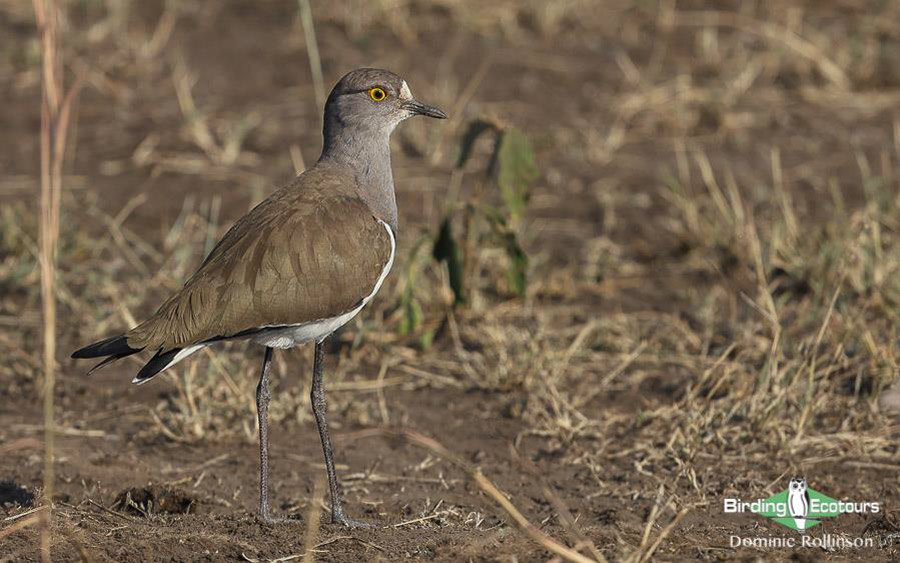
Senegal Lapwings were seen in open areas in Lake Mburo National Park.
Later that afternoon, we made our way back into the national park and headed towards Lake Mburo itself for our much-anticipated boat trip. We again took our time driving through the park and saw more of the regulars, including Crested Francolin, Red-necked Spurfowl, African Openbill (the same bird we saw earlier in the day at its puddle), Lilac-breasted Roller, Black-headed Oriole, Tropical Boubou and Lesser Masked Weaver. We arrived in the late afternoon for our boat ride, which took less than five minutes for us to find our primary target, African Finfoot. The initial sighting of this bird was brief, but over the course of the next two hours, we had multiple prolonged sightings of this unusual bird. Another big target of the boat cruise was White-backed Night Heron which we too found on this trip. It took a lot of maneuvering of the boat from the skipper and changing of our angles, but we eventually all had seen enough to piece the birds together. Other common waterbirds included Black Crake, Water Thick-knee, Hamerkop, Common Sandpiper, Striated Heron and Malachite and Pied Kingfishers. At the same time, a couple of large flocks of Splendid Starlings further kept us entertained. We drove out through the park as the sun was setting and managed flight views of Swamp Nightjar while Fiery-necked Nightjar and African Scops Owl would make it onto the heard-only list for now.
Day 4, 14th July 2023. Lake Mburo to Kisoro, birding en route
We had an early breakfast and then enjoyed a casual walk around the lodge grounds, where we hoped to find Striped Pipit. The pipit would not show, however, we did find large flocks of Splendid Starlings and African Green Pigeons feeding in a large fig tree and also saw Brown-throated Wattle-eye, African Paradise Flycatcher, Yellow-throated Leaflove and Green-headed Sunbird in the general area.
We then packed the vehicle and were soon on our way, with a quick stop for Slate-colored Boubou as we left the area, which also produced African Hoopoe and our first looks at House Sparrow (which caused much excitement). On our way out of the Lake Mburo area, we stopped at a wetland which was just alive with birds and we did not know which way to look. In no time at all, we had added Grey Crowned Crane, African Openbill, Little Bittern, Rufous-bellied Heron, Glossy Ibis, African Marsh Harrier, Greater Swamp Warbler, Highland Rush Warbler and even managed views of a couple of skulking African Rails. In the nearby fields, we found a few more Brown-chested Lapwings and Fan-tailed Widowbirds. We made one final stop at a small dam for White-backed Ducks, which showed well before we hit the long road towards Kisoro, right in the southwest of the country.
We had a late lunch stop on the edge of Lake Bunyonyi, where we enjoyed good looks at Bronzy Sunbird, White-browed Robin-Chat, Black-crowned Waxbill and Western Citril before we moved onto Echuya Forest Reserve. Despite the heat of the early afternoon, Echuya was its usual birdy self and a couple of hours birding here produced Cinnamon-chested Bee-eater, White-browed Crombec, Chubb’s Cisticola, Rwenzori Hill Babbler, Sharpe’s Starling, Dusky-blue Flycatcher, Northern Double-collared Sunbird, Red-headed Malimbe and our first Albertine Rift endemics in the form of Regal Sunbird, Rwenzori (Collared) Apalis and brief views of Strange Weaver.
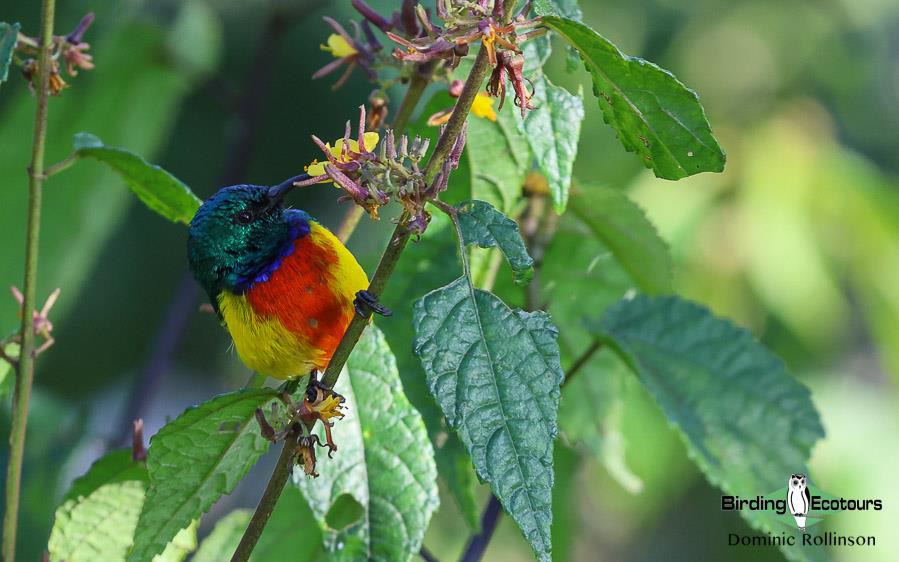
Regal Sunbird, a stunning Albertine Rift endemic.
After a long day on the road, we made it to our lovely accommodation just outside of Kisoro, which is beautifully set alongside a stream and makes for a tranquil atmosphere, with plenty of exciting birds around.
Day 5, 15th July 2023. Mgahinga Gorilla National Park birding
Today was another exciting day as we spent a large portion of the day in Mgahinga Gorilla National Park and hiked up the slopes of Mount Sabyinyo in search of a few localized specials. The 12,000-foot (c. 3,700 meter) Mount Sabyinyo is an extinct volcano (one of three impressive extinct volcanoes in the area) which falls on the border of Rwanda, the DRC and Uganda. It is found within three separate parks in these different countries, Virunga National Park in the DRC, Volcanoes National Park in Rwanda and Mgahinga Gorilla National Park in Uganda. We had most of the day to slowly hike up the slopes, with Rwenzori Turaco and Rwenzori Double-collared Sunbird being our two primary targets.
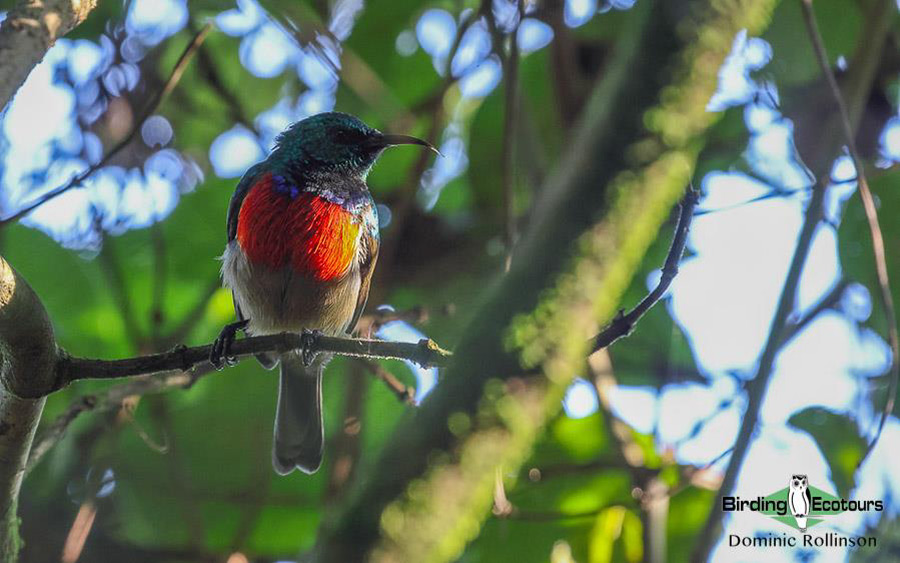
Rwenzori Double-collared Sunbird was seen well on the slopes of Mount Sabyinyo.
After arriving in the park, we soon set out for our hike with our local guide, Patrick, and a couple of armed park rangers. It did not take long at all to find Rwenzori Double-collared Sunbird, which showed well, and we noted its heavier bill and longer tail, which differentiates it from the similar Northern Double-collared Sunbird. Other species seen on the initial stretches of the trail included Dusky Turtle Dove, Cinnamon-chested Bee-eater, Rwenzori Batis, Cinnamon Bracken Warbler, Northern Puffback, Mountain Masked and Chestnut-throated Apalises, Yellow-whiskered and Olive-breasted Greenbuls, Red-faced Woodland Warbler, Rwenzori Hill Babbler, White-starred Robin and Streaky Seedeater. We heard the high-pitched calls of Dusky Crimsonwing; however, we could not see any of these little beauties (yet). Heading further up the slopes, we added the likes of Levaillant’s Cuckoo, Western Tinkerbird, Mountain Yellow Warbler, White-eyed Slaty Flycatcher and a large flock of Kandt’s Waxbills. After much work, we eventually managed to get good views of Albertine Sooty Boubou, which we had been hearing for most of the morning. We only managed brief views of the vocal and elusive Doherty’s Bushshrike and would have to wait a little longer for better views of this stunning species.
We eventually made it to our turnaround point, where we enjoyed a well-earned break in the shade and tucked into our lunch packs. We then ventured a little further into the bamboo section, which was very quiet, and so decided to start slowly making our way back down. We had yet to see (or even hear) Rwenzori Turaco, and just as a bit of dipping dread was starting to creep in, we heard a bird call from relatively close by. After a bit of work, we eventually managed to see a pair of these strange-looking turacos as they bounced around the trees and did a couple of flybys showing their brilliant red wings, which is due to the presence of the pigment, turacin (after which turacos get their name and which is only found in this bird family).
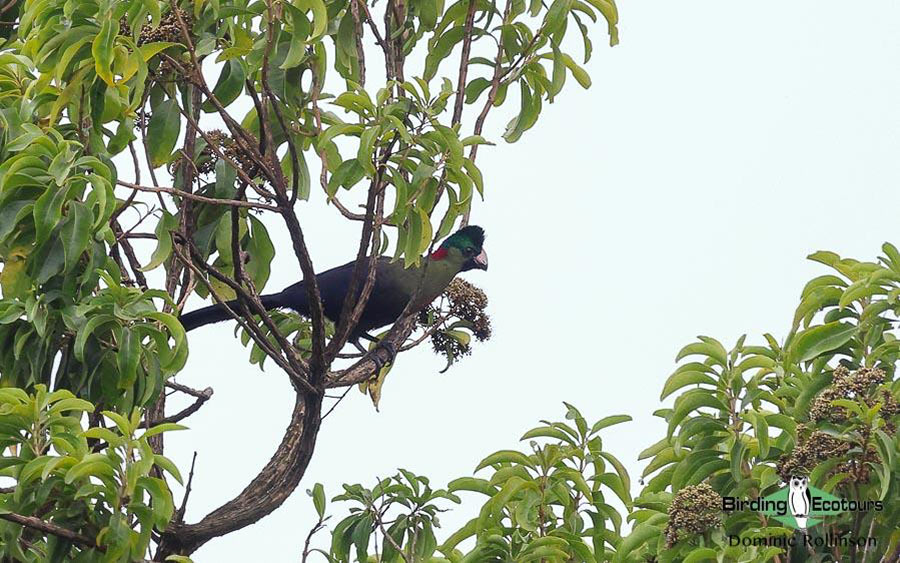
The unusual Rwenzori Turaco took some effort to find.
After seeing the turaco, we could relax a bit and concentrate on some of the many other birds around, including a small flock of Scarce Swift, brief views of a White-tailed Crested Flycatcher and right at the end of the walk, a calling Dwarf Honeyguide (well picked up on, William) which is a very difficult Albertine Rift endemic.
After a long day out, we decided to put our feet up back at our lodge and just enjoy our surroundings. However, we had a few birding distractions while we were relaxing and managed some lovely views of the striking but scarce White-collared Oliveback as well as a flyover African Spoonbill and Yellow-billed Stork. The day ended wonderfully well when we found a calling Western Barn Owl in the lodge grounds later that evening.
Day 6, 16th July 2023. Kisoro to Ruhija, papyrus birding en route
We ate breakfast just before dawn this morning and were soon out the door as we were transferring to the Ruhija section of Bwindi Impenetrable Forest, with some fine birding stops scheduled en route. Our first stop was on a winding road overlooking a lake where we added Red-knobbed Coot and a few Red-rumped Swallows lazily flying overhead. We then excitedly made our way back into Echuya Forest, this time at a much better time of the day, and soon started finding some of our missing targets. We yet again had brief views of Strange Weaver (they unfortunately would just not sit still!) along with African Olive Pigeon, Grey Cuckooshrike, Mountain Oriole and the best of the lot, prolonged views of a calling Barred Long-tailed Cuckoo.
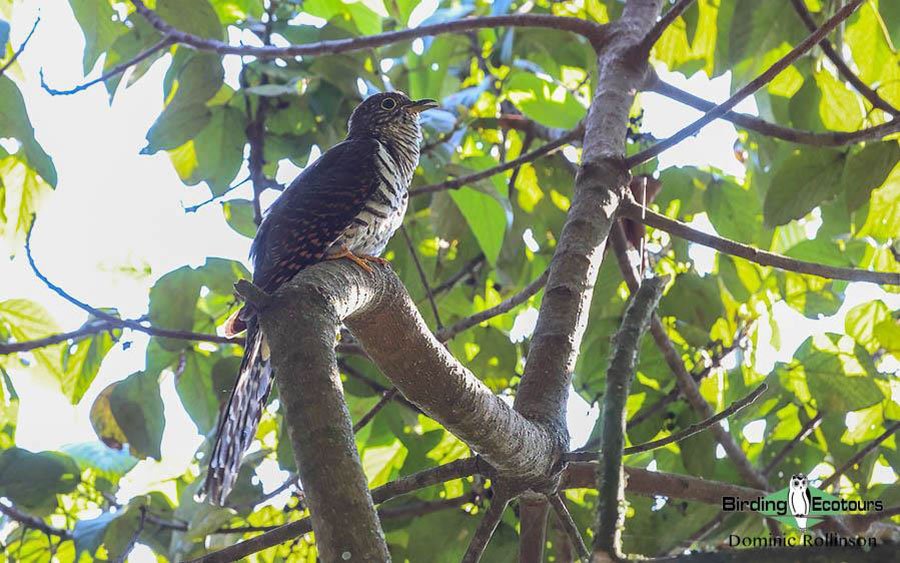
Barred Long-tailed Cuckoo seen in Echuya Forest.
It was then time for a quick break from forest birding as we made our way to the edge of Lake Bunyonyi to try for a few swamp specials. Papyrus Yellow Warbler proved remarkably easy and showed up without much of a wait, with Mackinnon’s Shrike and Carruthers’s Cisticola showing well too, while Black-and-white Mannikin made a brief flyby. We tried for Red-chested Flufftail, and although we saw some grass move and heard a call response, we could not lay eyes on these notorious skulkers.
Next, it was time to target Papyrus Canary in a nearby swampy area on the edge of some millet fields. We spent a lot of time working through flocks of Western Citril as well as Black-and-white Mannikin, Black-crowned and Common Waxbills and an assortment of weavers, including Black-headed, Northern Brown-throated and Slender-billed Weavers. After a while, Barabara spotted a pair of canaries sitting up in the papyrus, which turned out to be our primary target, Papyrus Canary. We also enjoyed watching Augur Buzzard and Wahlberg’s Eagle as they soared above us. We then enjoyed our lunch on the edge of Lake Bunyonyi, with many Red-chested and Bronzy Sunbirds around as happy distractions.
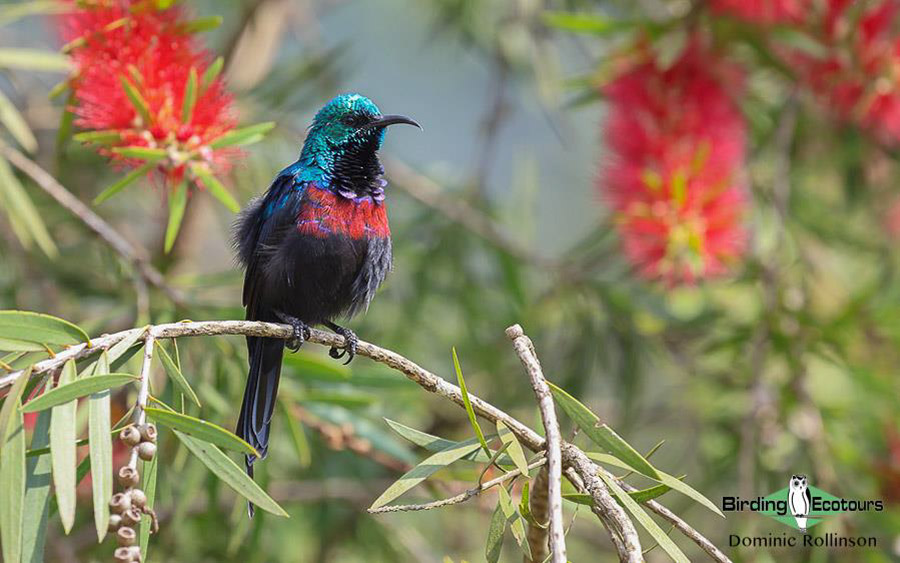
Red-chested Sunbirds were common throughout this tour.
After lunch, it was time to move on to the Ruhija section of the famous Bwindi Impenetrable Forest. The drive across was uneventful, and after arriving in Ruhija, we took some time off in the early afternoon before our late afternoon’s birding outing.
After meeting up with our eagle-eyed local guide, Gordon, we decided to spend some time birding the farmlands just outside of Ruhija, targeting Dusky Twinspot. Despite some focused searching, we could not find the twinspots, however, we did come across some other good bird species, such as Red-rumped Swallow, African Stonechat, Variable Sunbird, Streaky Seedeater, Yellow-crowned Canary and a juvenile Rufous-chested Sparrowhawk (well spotted Barbara!). We then birded some nearby patches of forest where we found Great Blue Turaco, Western Tinkerbird, Northern Double-collared Sunbird and best of all, a very showy Doherty’s Bushshrike which sat preening in the sun for us. We also saw a few Carruther’s Mountain Squirrels while birding in the forests. We then took a drive towards the bamboo section of Bwindi in the hopes of finding the tricky Handsome Spurfowl, which unfortunately would not oblige for us.
Day 7, 17th July 2023. Birding the highlands of Ruhija
Today would normally have been the day we undertake the long trek down to Mubwindi Swamp to look for Grauer’s Broadbill and Grauer’s Swamp Warbler; however, due to the difficulty of the walk, we decided to rather just bird the roadside and farmlands for the day. We were keen for another shot at Dusky Twinspot, and this time, the birds showed well within 15 minutes of arriving at the site, and we also found Slender-billed Starling and Lanner Falcon in the area.
We then birded a section of forest along the main road near Ruhija, which proved very productive, and we found many of our targets. Standout species included Yellow-billed and Grey-throated Barbets, White-tailed Blue Flycatcher, Black-throated and Mountain Masked Apalises, Mountain Yellow Warbler, Red-faced Woodland Warbler, Waller’s Starling, Abyssinian Thrush, Blue-headed and Regal Sunbirds and Thick-billed Seedeater. We tried a few favored spots for the gorgeous Dusky Crimsonwing, but this species continued to elude us.
After lunch and a short break, it was time to bird the famous Ruhija school track, which again proved incredibly productive. After Gordon’s morning in Mubwindi Swamp, we were happy to have him join us again and were thoroughly impressed by his knowledge of calls and ability to pick out any bird movement. First up was Stripe-breasted Tit (an Albertine Rift endemic), which was soon followed by a pair of Equatorial Akalats which showed surprisingly well in the dark undergrowth. We kept hearing the secretive Grauer’s Warbler, but unfortunately, it would not show for us today; the loud and colorful Black-billed Turaco, however, put on a fantastic show for us. Over the next couple of hours, we managed to get views of a great many forest species, including African Olive Pigeon, Cinnamon-chested Bee-eater, Rwenzori Batis, Lühder’s Bushshrike, White-chinned Prinia, Rwenzori and Mountain Masked Apalises, Yellow-streaked Greenbul, Mountain Illadopsis and Regal Sunbird. We heard Red-headed Bluebill, but despite our best efforts, we could not lay eyes on this attractive finch.
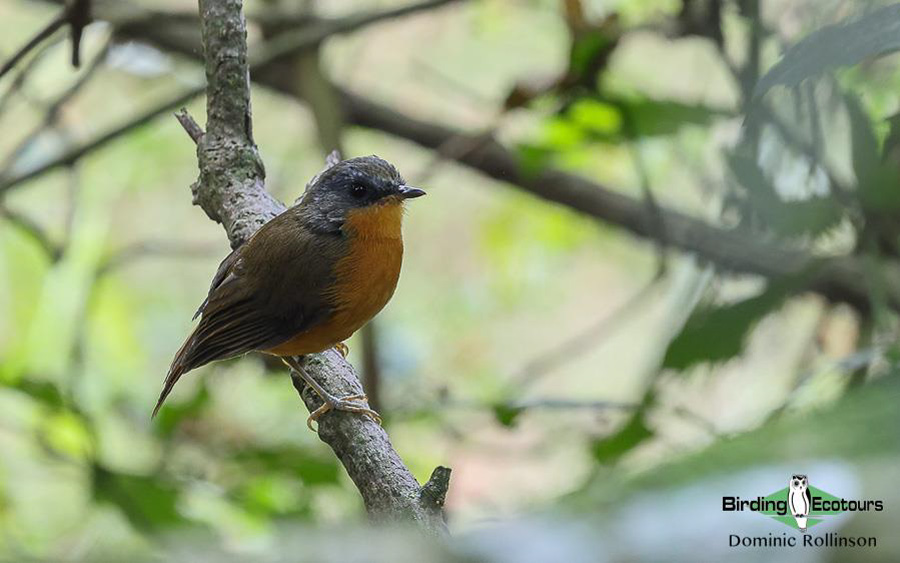
Equatorial Akalat was seen well in the Ruhija area.
To finish off the day, we headed back into the bamboo zone to see if we could find any Handsome Spurfowl, but the best we could do was to hear some rather distant birds calling from the valleys below us. We drove back along the road as it was getting dark and flushed a Montane Nightjar that was too quick for us all to get onto; however, a pair of African Wood Owls did pose nicely for us.
Day 8, 18th July 2023. Birding Ruhija and The Neck, and transfer to Buhoma
This morning, we were keen to try and track down a few missing targets and so headed back to the bamboo zone. Handsome Spurfowl was again not playing ball; however, we did find White-headed Wood Hoopoe, and finally, all got good (although brief) looks at Dusky Crimsonwing, which was one of David’s most-wanted targets. We headed back to the school track for one more go at Grauer’s Warbler, which eventually showed briefly for us (along with a couple of Blue Monkeys) before we made our way out of Ruhija towards Buhoma with some birding en route at The Neck to look forward to. As we were leaving the forests of Ruhija, we stopped to enjoy a group of handsome Guerezas (Black-and-white Colobus), which posed nicely for us.
We spent a good few hours birding at The Neck, which proved to be some of the best birding of the trip, and also enjoyed our lunch break in the relative cool of the forest. A stop at the stream failed to deliver the hoped-for Mountain Wagtail and Cassin’s Flycatcher; however, we did find Speckled Tinkerbird, Petit’s Cuckooshrike, Klaas’s Cuckoo, White-browed Crombec and White-breasted Nigrita.
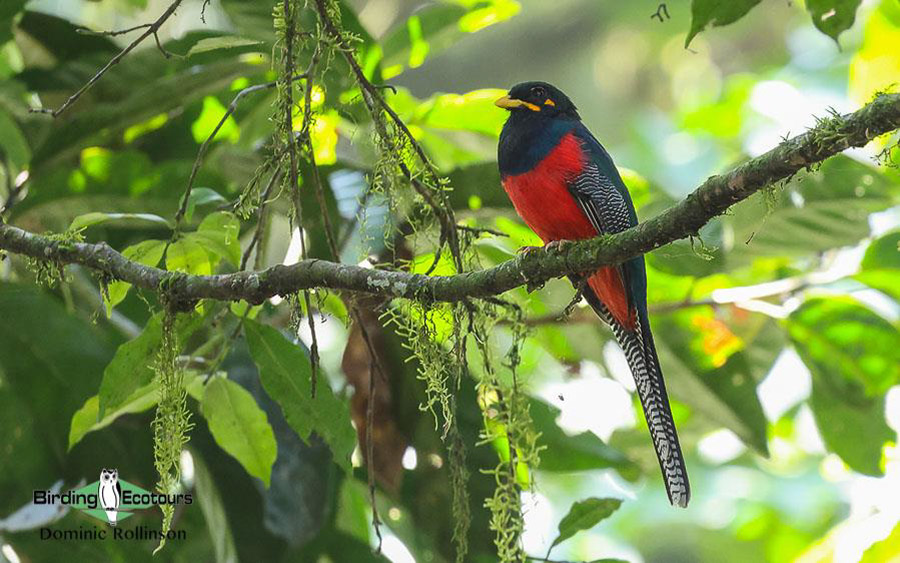
We had splendid views of Bar-tailed Trogon while birding The Neck.
A little further into the forest, we bumped into a bird party, which left us not knowing which way to look, and we soon racked up Ansorge’s, Plain, Red-tailed, Yellow-whiskered and Honeyguide Greenbuls, Banded Prinia, Bar-tailed Trogon, Yellow-spotted Barbet and Black-billed Weaver. After our lunch, the high-octane birding continued with more feeding flocks producing Blue Malkoha, Bocage’s Bushshrike, Grey-headed Sunbird, Brown-capped Weaver, Slender-billed Starling and Black-and-white Shrike-flycatcher. We waited on the edge of a small wetland and eventually had good looks at a pair of African Black Ducks, which are often seen here.
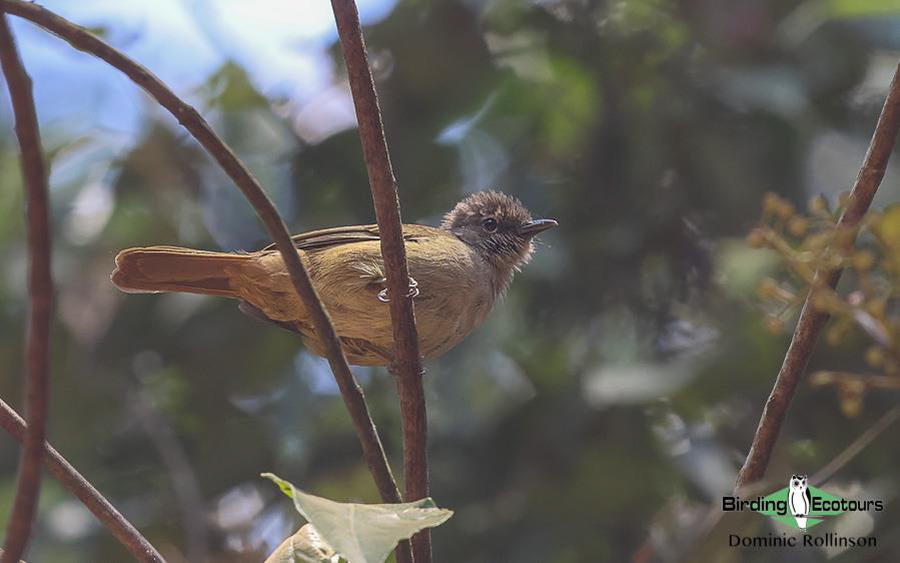
The subtly beautiful Ansorge’s Greenbul at The Neck.
We arrived in the early afternoon in Buhoma, checked into our lodging and had a short break before our late-afternoon birding session. This afternoon, we birded the entrance road to the Buhoma section of Bwindi Impenetrable Forest, which again proved productive for us. Right at the park entrance, a flowering tree was attracting lots of feeding sunbirds, including Green-headed, Green-throated, Olive-bellied, Bronzy and Northern Double-collared Sunbirds. Soon after starting our walk, we bumped into Wilcock’s Honeyguide – a tricky forest species, while a flyover Cassin’s Hawk-Eagle was another unexpected bonus. We worked our way through various feeding flocks, which contained Many-colored Bushshrike, Petit’s Cuckooshrike, Narrow-tailed Starling, Dusky-blue Flycatcher, Grey-throated Tit-Flycatcher and Little Green Sunbird, before we called it a day and enjoyed a traditional Ugandan dinner.
Day 9, 19th July 2023. Buhoma main trail birding
We had another early start this morning as we were to spend most of the day birding the Buhoma main trail, which offers superb deep-forest birding. We took lunch packs along with us and spent the morning and early afternoon birding in the forest interior, which produced a fine list of forest specials. Some of the day’s highlights included Bar-tailed Trogon, Grey-throated and Yellow-spotted Barbets, Cassin’s Honeyguide, Chestnut Wattle-eye, Pink-footed Puffback, Dusky Tit, Black-throated Apalis, Black-faced Rufous Warbler, Ansorge’s, Plain, Yellow-whiskered and Little Greenbuls, Sooty Flycatcher, Blue-throated Brown Sunbird and African Broadbill which we enjoyed watching for a while as it performed its display flight. At our turnaround, point we searched for Neumann’s Warbler, which although we heard nearby, we could not obtain any visuals of this cryptic forest skulker. During our walk, we also enjoyed several sightings of the attractive L’hoest’s Monkey, which were not at all perturbed by our presence. Before exiting the forest, we had an exciting encounter with the relatively large Yellow-backed Duiker, which walked along the path up to us before diving into the thick bush; we also saw several Black-fronted Duiker today. On our way back out through the secondary forest, we managed to find Grey-winged Robin-Chat and Elliot’s and Buff-spotted Woodpeckers, as well as White-rumped Swift and Red-rumped Swallow overhead.
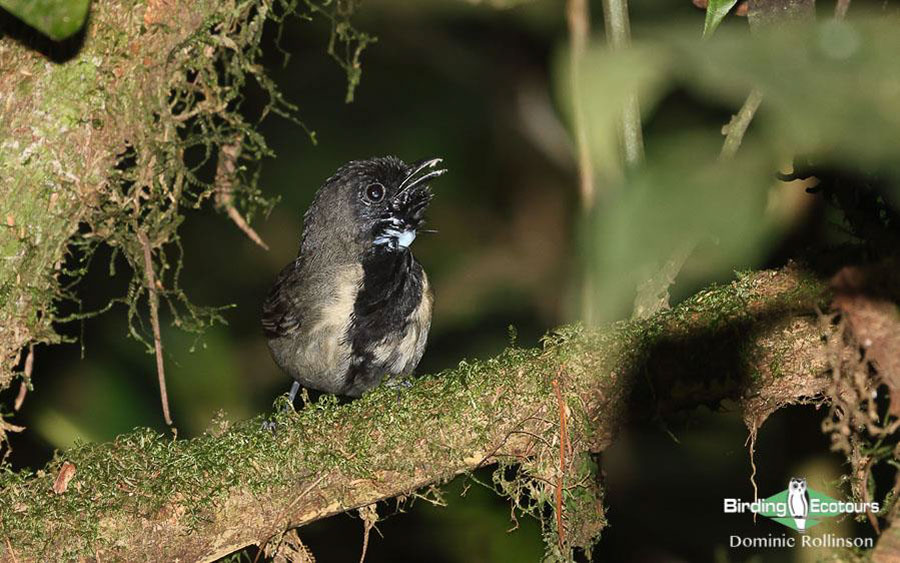
This female Black-faced Rufous Warbler showed well for us in Bwindi Impenetrable Forest.
For our afternoon birding session, we decided to take a break from forest birding and rather birded the farmlands outside of Buhoma town. Some of the afternoon’s highlights included Tambourine Dove, Ross’s Turaco, Eastern Plantain-eater, White-browed Coucal, Woolly-necked Stork, Palm-nut Vulture, White-winged Black Tit, Holub’s Golden Weaver, and two pairs of Wahlberg’s Eagles which were seen displaying to each other. This ended another fun day’s birding in the forests of Uganda.
Day 10, 20th July 2023. Gorilla trekking and late afternoon forest birding
Today was an exciting day for Barbara as she was heading out gorilla trekking for the morning. We dropped Barbara at the park headquarters, and then David, Gordon and I carried on back into the forests as we would again be birding the entrance road and the streamside track. We had many of the same species as yesterday, including Tambourine Dove, Grey-throated Barbet, Buff-spotted Woodpecker, Petit’s Cuckooshrike, Chestnut Wattle-eye, Black-and-white Shrike-flycatcher, Bocage’s Bushshrike, Green Hylia, Brown-capped Weaver and Grey-winged Robin-Chat. We had to work for our new birds but did manage to find African Goshawk, African Shrike-flycatcher, Red-tailed Bristlebill and Toro Olive Greenbul before we headed back to the park headquarters to meet up with Barbara. We were pleased to hear that Barbara had thoroughly enjoyed her time with the Eastern (Mountain) Gorillas and was lucky enough to have a small group of tourists along with her (rather than the full complement of eight), which made for a more enjoyable experience. After our busy mornings, we headed back to our lodge for a sit-down lunch and some time off in the early afternoon.
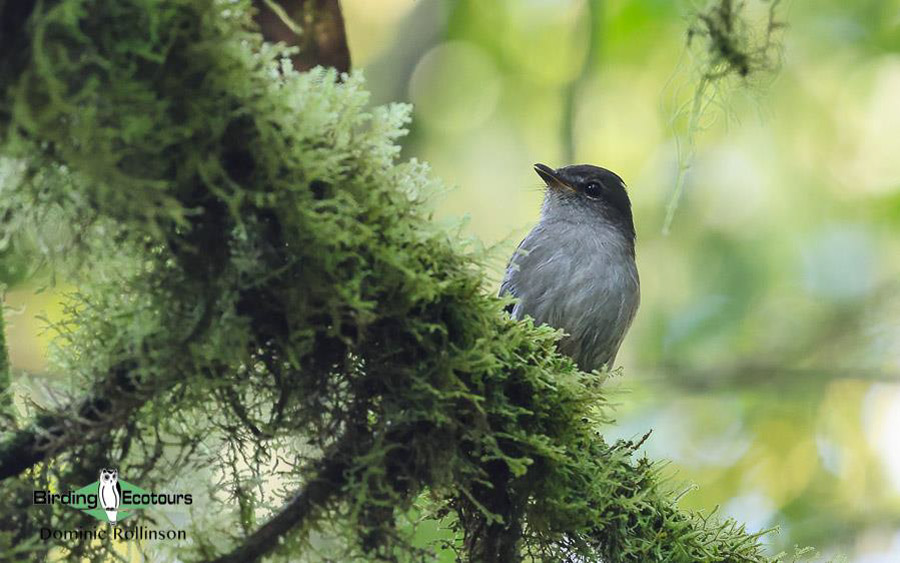
Chapin’s Flycatcher was another highlight of our time at Buhoma.
Later that afternoon we headed back out for our final session of birding the Buhoma entrance road to see if we could find some of the species that Barbara had missed in the morning while she was out gorilla trekking. The forest was very quiet this afternoon; however, we still enjoyed our walk along the edge of the stream and even managed to bump into a family group of Eastern (Mountain) Gorillas which was unexpected bonus. After a bit of work, we found a small group of Red-tailed Bristlebirds, which was a catch-up bird for Barabara. Feeling content after our time birding in Buhoma over the last couple of days, we headed back to our lodge for a good night’s sleep before an early start the next morning.
Day 11, 21st July 2023. Transfer to and birding Queen Elizabeth National Park
We had a pre-dawn breakfast before we were in our vehicle and started the transfer to Queen Elizabeth National Park. En route, we stopped near the town of Kasese, where we quickly found a Red-throated Wryneck, which posed well for us with a confiding trio of Grey Crowned Cranes feeding nearby. After refueling and drawing some cash in Kasese, we soon entered the national park and slowly started making our way northwards. Immediately, the birding picked up, and we soon saw the likes of Common Scimitarbill, Olive Bee-eater, Cardinal and Green-backed Woodpeckers, Northern Fiscal, Red-faced, Trilling and Croaking Cisticolas, Red-billed Quelea and White-winged Widowbird.
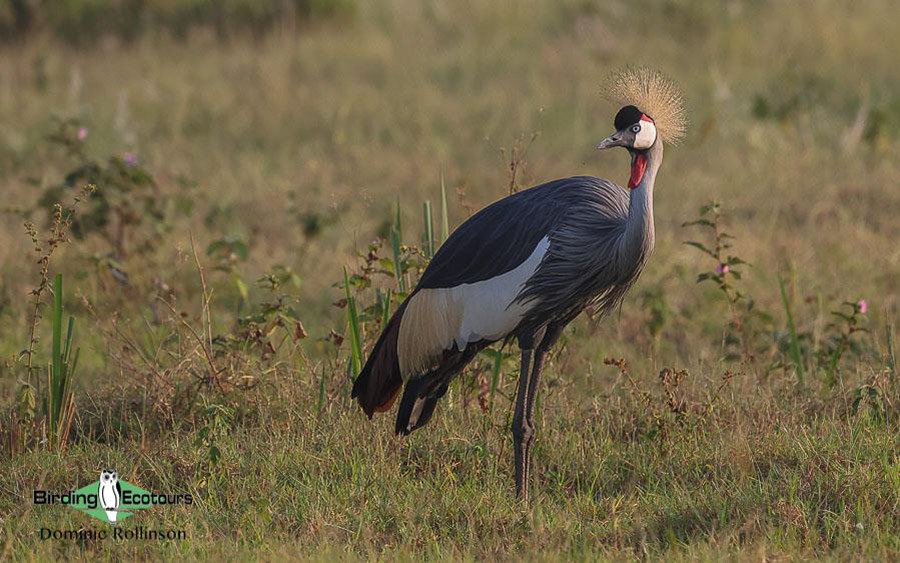
Grey Crowned Cranes were commonly encountered on this tour.
After a little while, we entered the Ishasha sector of the park; however, by this point, things had started to warm up, and the area was perhaps not quite as productive as it often can be. Despite this, we saw some good birds, including Blue-spotted Wood Dove, Marabou Stork (much to David’s delight), Hamerkop, Palm-nut, White-backed and Rüppell’s Vultures, Bateleur (which loosely means tight-rope walker in French, from its habit of tilting its wings as it flies), Brown Snake Eagle, Lesser Honeyguide, Black-headed Gonolek, Banded Martin, Flappet Lark, Quailfinch, and a pair of Verreaux’s Eagle-Owls at their day roost. We were hoping for sightings of tree-climbing Lions while in the Ishasha sector; however, we had no such luck today.
After a quick picnic lunch (while being distracted by a group of Buff-bellied Warblers), we carried on north through the park (finding a flock of Western Crested Guineafowl en route), eventually arriving at our comfortable lodge in the early afternoon. After a quick rest, we were soon out the door again and this time birded some grasslands near our lodge, where we found Moustached Grass Warbler and Marsh Tchagra but could only briefly hear Fan-tailed Grassbird, never managing to lay eyes on it.
A quick stop at the Kazinga Channel bridge eventually yielded the secretive Papyrus Gonolek (well spotted William) as well as Malachite and Pied Kingfishers, Wire-tailed Swallow and Winding Cisticola. We made a stop for nightjars on our way back which resulted in a brief view of Fiery-necked Nightjar; however, the calling Square-tailed Nightjars would not show for us.
Day 12, 22nd July 2023. Kasenyi Track birding, Kazinga Channel boat cruise and transfer to Kibale Forest
We enjoyed an early breakfast before we packed our bags and were again out early, watching the sun rise as we headed towards the Kasenyi Track. We would be birding this famed track for the morning before heading out on our lunchtime Kazinga Channel boat cruise. After sorting out the entrance fees, we were soon on our way along the track, which proved very birdy and added many new birds to our already impressive bird list. Some of the highlights of the morning included Red-necked Spurfowl (many), Mourning Collared Dove, African Crake, Senegal Lapwing, Common Buttonquail, Dwarf Bittern, Bateleur, Yellow-billed Kite, Green Wood Hoopoe, Grey Kestrel, White-tailed, Flappet and Red-capped Larks, Stout Cisticola, Yellow-billed Oxpeckers (feeding on the large herds of African Buffalo in the area), Quailfinch and Plain-backed Pipit. The area is well-known for its large numbers of game, and today, we managed to find a male Lion, a single Leopard resting in a tree, impressive herds of African Buffalo as well as Common Warthog, Kob and Waterbuck. We enjoyed the views out over Lake Bunyampaka (a crater lake), where we scoped small numbers of Lesser Flamingo, Black-winged Stilt, Spur-winged Lapwing, Common Greenshank and Kittlitz’s Plover.
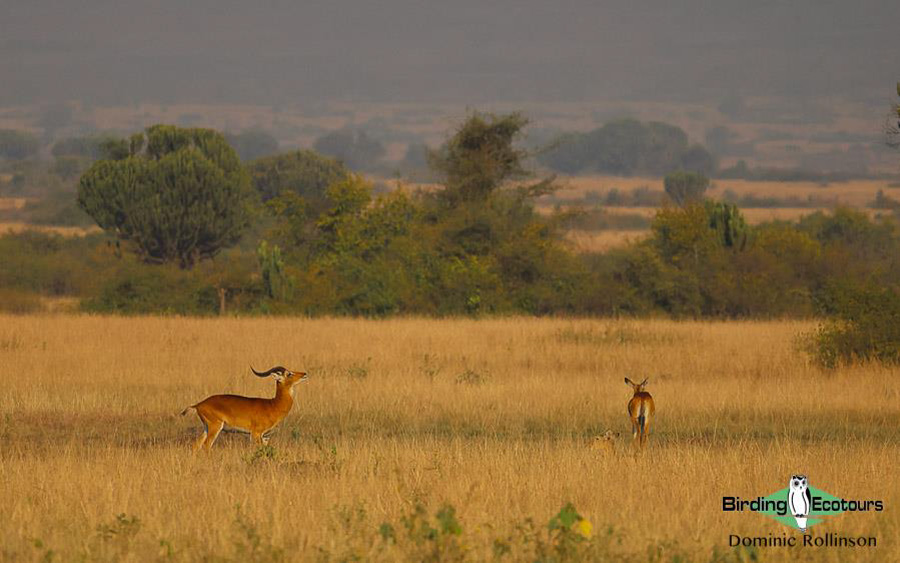
Kob are abundant in many f Uganda’s national parks.
It was then time to make our way west, enjoying a quick lunch before heading out for our much-anticipated boat cruise of the Kazinga Channel. This cruise is always a very enjoyable one, with large numbers of both birds and animals on display. Today was no different as we watched large numbers of African Elephants coming down to drink, as well as small numbers of Forest Hogs sheltering in the shade. The impressive numbers of Hippopotamuses kept us entertained as they lounged around with a few good-sized Nile Crocodiles seen basking on the exposed banks. Unfortunately, the water levels were too high for African Skimmers, which we had hoped to see, and there were none of these charismatic birds around.
Despite the lack of skimmers, the birding overall was excellent, and by working through the more familiar species we were able to pick out Knob-billed Duck, Water Thick-knee, African Jacana, Common Sandpiper, Grey-headed Gull, Yellow-billed Stork, White-breasted Cormorant, Great White and Pink-backed Pelicans, Goliath and Squacco Herons, Pied Kingfisher (in the highest concentrations I have ever seen), Red-throated Bee-eater and many other widespread species.
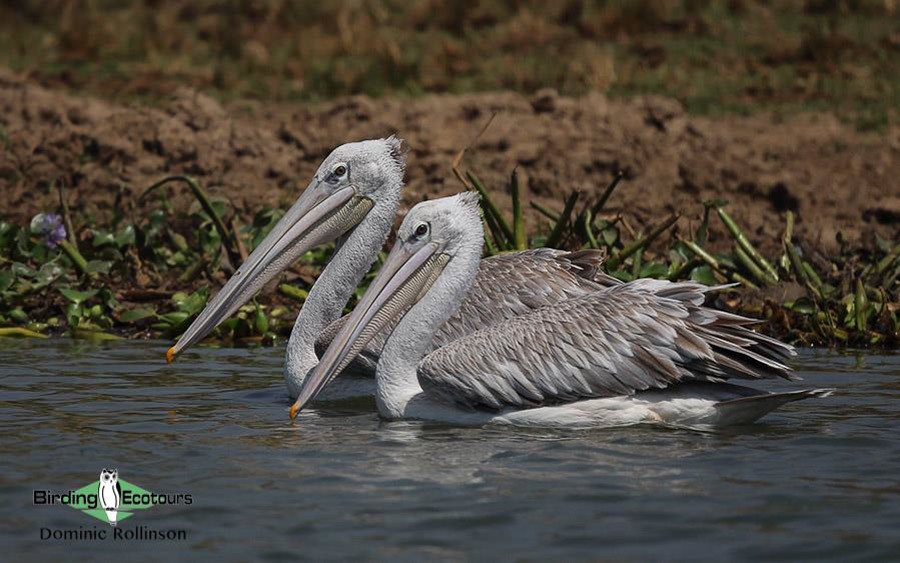
Pink-backed Pelicans on the Kazinga Channel.
After a relaxing and highly enjoyable cruise, we made the journey north to Kibale Forest, where we would be based for the next two nights. A quick stop as we drove through the forest added Sabine’s Spinetail and Purple-headed Starling before we arrived at our lodge as the sun was setting.
Day 13, 23rd July 2023. Kibale Forest birding
Today was another highly anticipated day of birding as we made our way into Kibale Forest pre-dawn to look for the most-wanted Green-breasted Pitta. The pittas had proven tricky this season, with a few previous birding tours having missed them. I had chatted to William about the pittas, and he had said from the start that he would make sure we saw them, and he stayed true to his word, as we had mind-blowing views for around 15 minutes watching a bird displaying, doing its little jump and wing drumming. It was a magical experience, and we were all very relieved to have seen this attractive and elusive species. While out looking for the pittas, we also found Brown Illadopsis, Yellow-throated Tinkerbird and heard many Western Orioles, although we could not lay eyes on them yet.
After our successful morning out, we birded the forest edge, which proved equally productive as we soon found Jameson’s Wattle-eye, Lowland Masked and Grey Apalises, Blue Malkoha, Western Nicator (which William somehow spotted sat on its nest!), African Shrike-flycatcher (catchup bird for Barbara), Plain Greenbul and Purple-banded Sunbird.
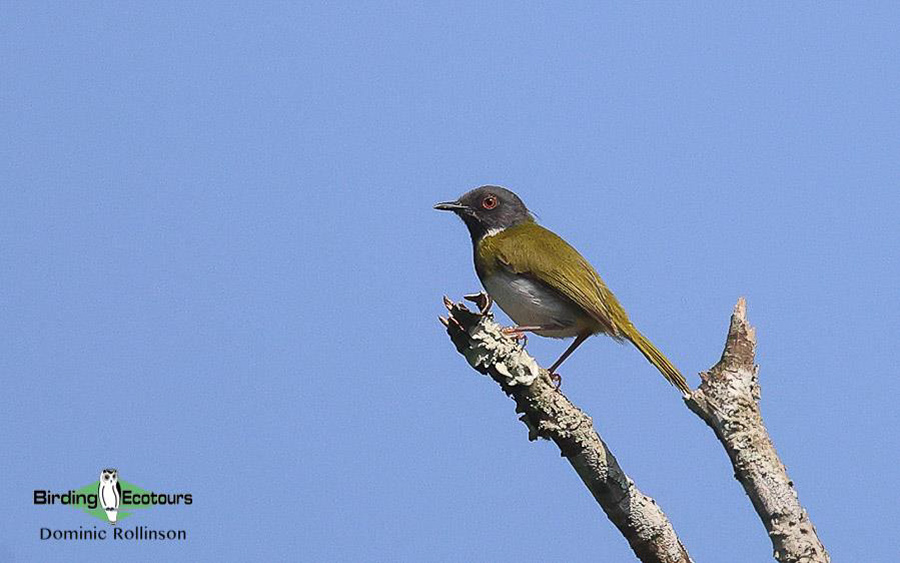
Lowland Masked Apalis was particularly confiding on the edge of Kibale Forest.
We then headed back to our lodge for a sit-down lunch and some time off in the early afternoon. Feeling refreshed, we headed out again for our afternoon’s birding around Bigodi Swamp. The birding was a little on the slow side; however, we did add some new birds in the form of White-spotted Flufftail (great looks as an individual walked across the path), Ayres’s Hawk-Eagle, Shining-blue Kingfisher (unfortunately missed by David and Barbara), Purple-headed Starling and a few flyover flocks of Magpie Mannikins.
Day 14, 24th July 2023. Kibale Forest birding and transfer to Masindi
Today we had the long transfer to Masindi ahead of us, but before that, we wanted to get in some last birding around Kibale Forest and the surrounds. After breakfast, we birded the area close to Bigodi Swamp, which was very productive, and we managed to find our primary target, Speckle-breasted Woodpecker. Other good birds seen included Brown-throated Wattle-eye, Black-and-white Shrike-flycatcher, African Blue Flycatcher, Copper Sunbird, Baglafecht Weaver and several showy Great Blue Turacos.
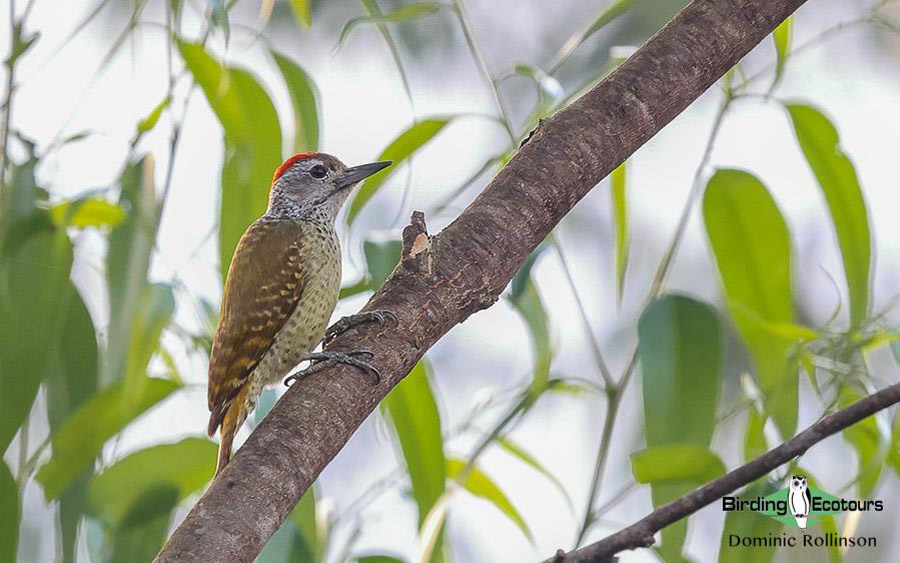
Speckle-breasted Woodpecker showed wonderfully well near Kibale Forest.
We then spent some time birding in Kibale Forest to try to find a few missing targets. A stop at the stream produced the hoped-for Cassin’s Flycatcher which we had missed previously, with other previously encountered species including African Shrike-flycatcher, African Green Pigeon, Black-billed Turaco, Sabine’s Spinetail, Grey-throated and Hairy-breasted Barbets, Yellow-throated Tinkerbird, Cassin’s Honeybird, Chestnut Wattle-eye, Dusky Tit, Purple-banded Sunbird and Grey-headed Nigrita. New trip birds included the likes of Afep Pigeon, Dusky Long-tailed Cuckoo (finally seen, after having heard it for the last few days), European Honey Buzzard, Red-capped Robin-Chat (brief glimpses as it flew across the road) and the aptly named Superb Sunbird. We were also lucky to be able to watch a group of Chimpanzees as they fed high up in a fruiting fig tree – it’s always a pleasure to watch these fascinating apes in the wild. Kibale Forest is well-known for its diversity of primates. While birding in the forest and general area over the last couple of days, we also noted Grey-cheeked Mangabey, Olive Baboon, Red-tailed Monkey and Ashy Red Colobus (which is the favored prey of Chimpanzees, due to their slow-moving nature).
After exiting Kibale Forest, the remainder of the day was mostly a travel day as we continued our way north to the town of Masindi. We made a stop for Red-headed Bluebill and another stop for Grey-headed Oliveback; however, both stops proved unsuccessful. After a long day on the road, we arrived in the late afternoon and enjoyed our dinner before heading to bed.
Day 15, 25th July 2023. Budongo Forest birding and transfer to Murchison Falls
We had a long day’s birding ahead of us today, with lots to fit in, so we decided on another pre-dawn breakfast before making our way out of Masindi, heading towards Budongo Forest. Before we made it into the forest, we had several birds to target in the farmlands on the outskirts of the forest. Our first stop was for White-winged Swamp Warbler, which did not take long to finally get visuals of, after having heard it many times previously. A few farmland stops proved very birdy, and it did not take long before we had accumulated an impressive list, including Senegal Coucal, Red-necked Falcon (well spotted David, this turned out to be our only sighting of the trip!), Marsh Tchagra, Moustached Grass Warbler, Short-winged Cisticola, Brown-backed Scrub Robin, Compact Weaver, Yellow-mantled and Red-collared Widowbirds, Black Bishop, Fawn-breasted and Orange-breasted Waxbills and African Firefinch. I had brief views of a small group of Brown Babblers, but unfortunately, nobody else got onto these birds.
We then moved around the corner to try for Grey-headed Oliveback with a pair of these attractive finches showing wonderfully well for a prolonged period. At the same time, we also had a pair of Brown Twinspots, which also showed well. In this area we further saw Red-headed Lovebird, Meyer’s Parrot, Grey-backed Fiscal, Snowy-crowned Robin-Chat, Compact Weaver and had a displaying African Goshawk overhead.
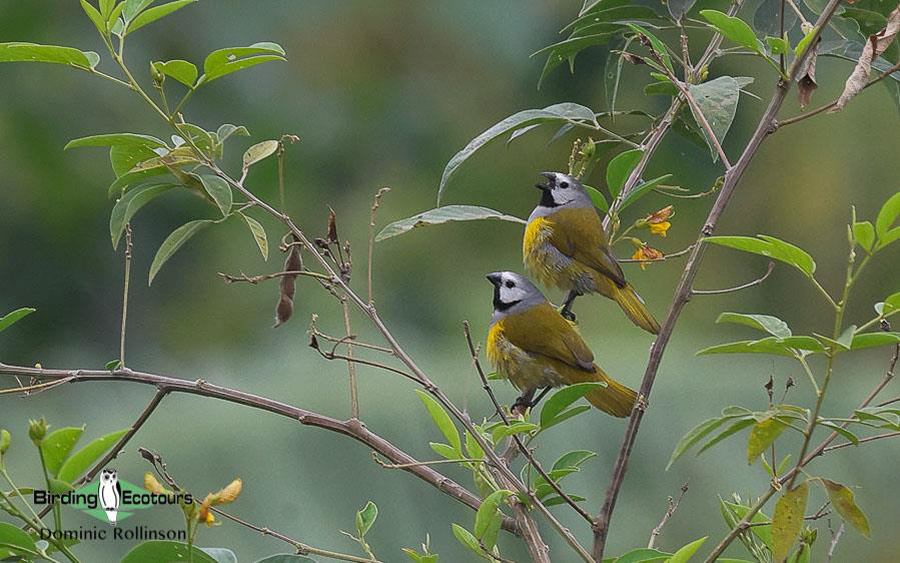
We could not have asked for better views of this pair of Grey-headed Olivebacks near to Budongo Forest.
Around mid-morning, we finally made it into Budongo Forest itself and proceeded to bird the famed Royal Mile which as always, was full of birds. Birding along the Royal Mile can be difficult at times, with flocks feeding high up in the canopy, often meaning a scope is needed to get views of many of the canopy dwellers. Our first feeding flock contained Little Grey Greenbul, Grey Longbill, Ashy Flycatcher, Little Green Sunbird, Green Crombec and Green Hylia. Nearby, we had superb views of a pair of Yellow-crested Woodpeckers. We then moved deeper into the forest and soon found a feeding party of birds high up in the canopy, which had us craning our necks upwards and managed to pick out Chestnut-capped Flycatcher and Spotted Greenbul, with glimpses of Rufous-crowned Eremomela and Ituri Batis (unfortunately Barbara and David missed these two). We had a fun time with kingfishers as we all managed good looks at African Pygmy and African Dwarf Kingfishers, with Chocolate-backed Kingfishers eventually showing very well for us. The calling Blue-breasted Kingfishers, however, would not show themselves, for now.
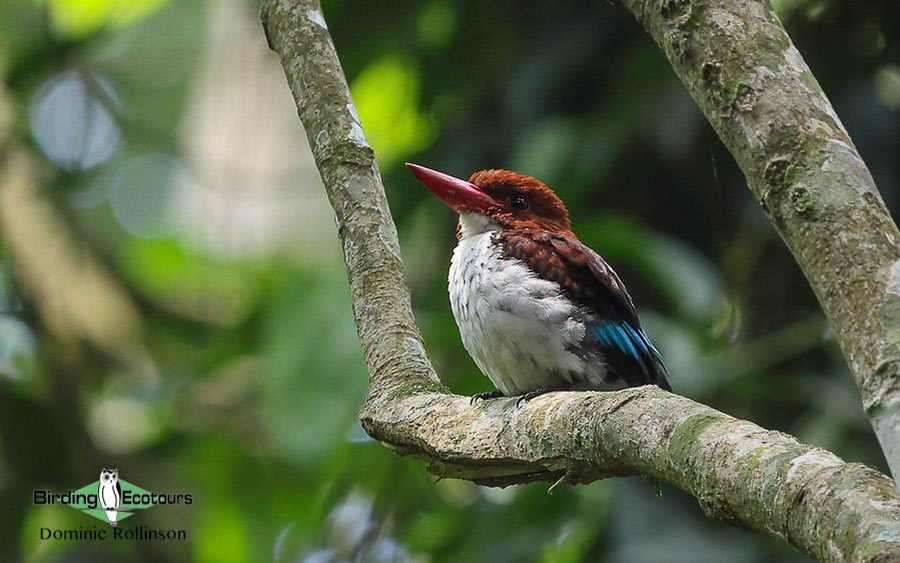
Chocolate-backed Kingfisher was one of the many kingfishers we saw along the Royal Mile.
After our picnic lunch, we continued to bird the forest and managed to find good birds in the form of White-thighed Hornbill, African Emerald Cuckoo (female), Western Oriole, Red-bellied Paradise Flycatcher, Fraser’s Rufous Thrush, Fraser’s Forest Flycatcher and Red-headed Malimbe. Unfortunately, we could not find the calling Uganda Woodland Warbler, which too was calling high up in the forest canopy.
After a few good hours of lowland forest birding, we decided it was time to hit the road and make our way towards Murchison Falls National Park. We wanted to take our time getting to Murchison Falls, as there was some fine birding to be had en route. We stopped off at the Butiaba Escarpment, where a drastic change in habitat (here dry woodlands) meant the new birds came rolling in thick and fast. Some of the exciting birds found here included Bateleur, African Hawk-Eagle, Swallow-tailed Bee-eater, Black-billed Barbet, Northern Crombec, Foxy Cisticola, Lesser Blue-eared Starling, Western Violet-backed and Beautiful Sunbirds, Vitelline Masked Weaver, Red-headed Quelea, Black-rumped Waxbill and Green-winged Pytilia. We moved further round the corner, where we had lovely views of Cinnamon-breasted Bunting, with the great birding continuing as we worked through the large flocks of seedeaters, picking out Cut-throat Finch and Village Indigobird. We then tried our best not to spot any exciting birds and drove the last hour or two to Murchison Falls, with William and I spotting a brief flyover Bruce’s Green Pigeon as we entered the park.
Day 16, 26th July 2023. Birding Murchison Falls National Park
We had the exciting prospect of the full day in Murchison Falls National Park today and so after an early breakfast, we crossed the bridge over the Nile River and enjoyed the day of birding and animal viewing. Woodland birding produced sightings of Black-billed Wood Dove, Jacobin Cuckoo, Grey-headed Kingfisher, Northern Carmine Bee-eater, Yellow-fronted Tinkerbird, Western Black-headed Batis, White-shouldered Black Tit, Black-crowned and Brown-crowned Tchagras, Rattling Cisticola, Silverbird, Spotted Palm Thrush, Chestnut-crowned and White-browed Sparrow-Weavers, Speckle-fronted Weaver, Shelley’s Sparrow, Black-bellied Firefinch and many others. The open grasslands had good numbers of Northern Red and Black-winged Bishops, Flappet Lark, Banded Martin, Black-headed Lapwing and a group of massive Abyssinian Ground Hornbills. Overhead, there were several raptors using the thermals, including Lappet-faced, White-backed and Rüppell’s Vultures, Bateleur and Martial and Wahlberg’s Eagles with Western Banded Snake Eagle and Dark Chanting Goshawk seen perched in tall trees. While out birding in the plains and savannas of Murchison, we noted good numbers of game, including Oribi, Waterbuck, Kob, Hartebeest and masses of African Buffalo.
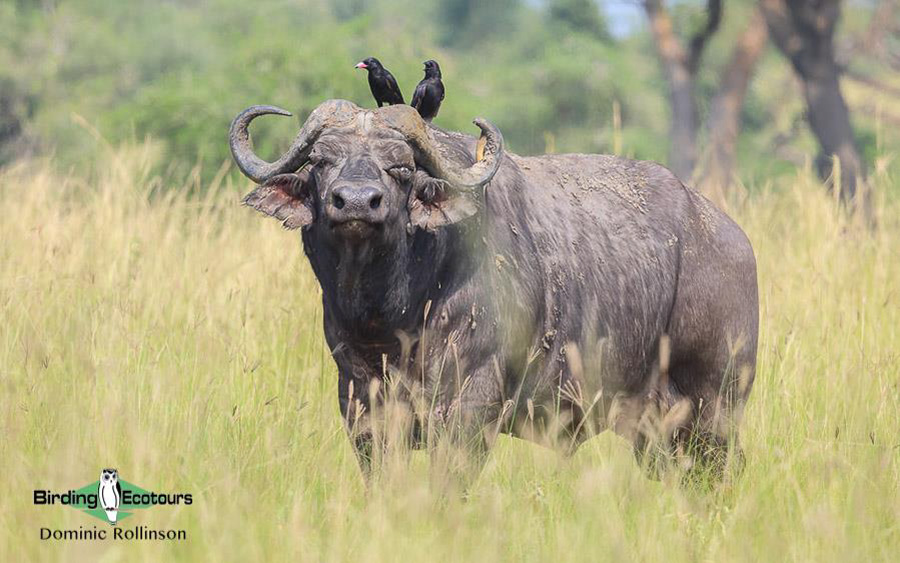
Piapiacs adorned the many African Buffalo in Murchison Falls National Park.
We enjoyed our lunch along the edge of Lake Albert, where we scoped Spur-winged and Long-toed Lapwings, Common Greenshank, African Openbill, Saddle-billed and Yellow-billed Storks, Intermediate Egret and Pink-backed Pelican before we started to slowly make our way back towards our lodge. We eventually made it back to our lodge in the late afternoon and decided to take the rest of the afternoon off and enjoy the beautiful lodge grounds and a quiet beer.
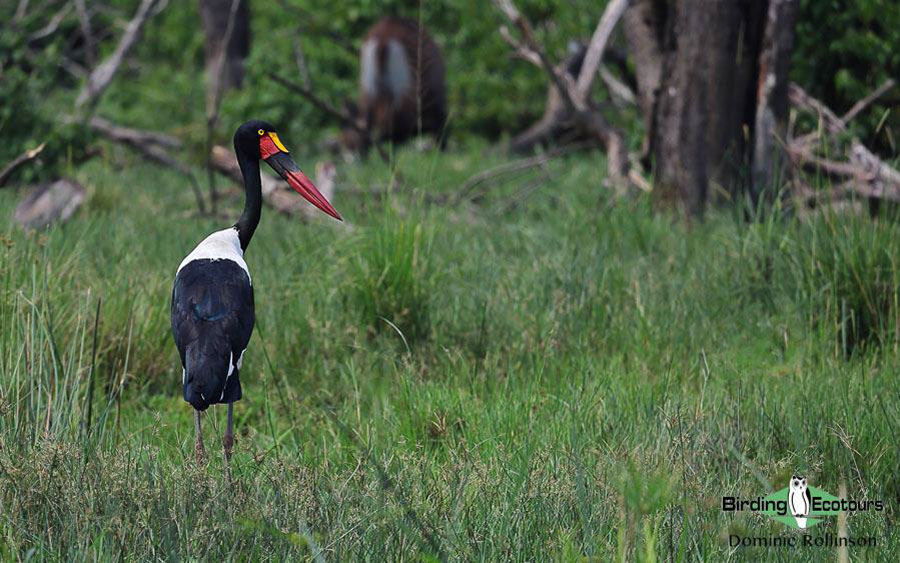
Saddle-billed Storks are often seen well in Murchison Falls National Park.
Day 17, 27th July 2023. Nile River boat cruise and birding Murchison Falls
This morning, we slowly birded the road between our lodge and Paraa, which again proved very productive with lots of new birds. We found a few bird parties, which contained the likes of Nubian Woodpecker, Western Black-headed Batis, White-crested Helmetshrike, White-shouldered Black Tit, Green-backed Eremomela, Red-winged Grey Warbler, Singing and Short-winged Cisticolas and Northern Yellow White-eye. We had to work for Grey-headed Bushshrike, but eventually, William spotted a bird calling from a distant tree, which we could all enjoy. William and I had a brief view of a male Red-shouldered Cuckooshrike as it flew across the road that was unfortunately missed by David and Barbara.
We then birded the northern side of the Nile River, which got us our two main targets for the day; White-crested Turaco and a small group of Dusky Babblers, with Pale Flycatcher and Bar-breasted Firefinch seen in the area too.
We had our picnic lunch on the edge of the Nile River while sat on a wobbly bench, which almost sent David and Barbara flying, but thankfully, all ended well, and we could laugh about it. It was then time for our Nile River boat cruise, which as always, proved to be very relaxing as we headed out to see Murchison Falls itself which is always impressive to see and hear. The birding was productive along the cruise, and we added Senegal Thick-knee, Rock Pratincole, Osprey, Giant Kingfisher and Common Swift to our trip list. Other nice birds to be seen included Red-throated Bee-eater, Goliath Heron, Grey Kestrel and Saddle-billed Stork. We also enjoyed some close-up sightings of African Buffalo, African Elephant, Hippopotamus and Nile Crocodile.
After our boat cruise, we birded the main road near our lodge in the hopes of finding Blue-breasted Kingfisher, which played hide-and-seek for a while before we eventually managed brief views of this attractive kingfisher. As the sun was setting, we drove a track where we managed a few brief flyover views of impressive male Pennant-winged Nightjars and had brief looks at Blue-throated Roller as it hawked insects in amongst the many Broad-billed Rollers.
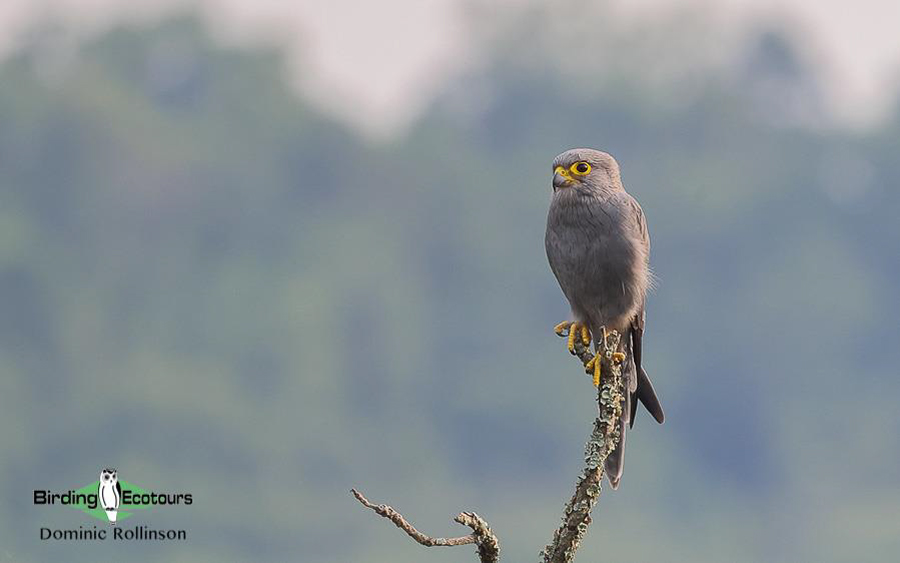
Grey Kestrel is common in savanna habitat across Uganda.
Day 18, 28th July 2023. Murchison Falls to Entebbe, with Ziwa Rhino Sanctuary en route
Today was our final full day of the tour, and we would be slowly making our way back to Entebbe, with several birding and wildlife stops to be enjoyed en route. After our sit-down breakfast we stopped at Kaniyo Pabidi Forest where we enjoyed some more lowland forest birding with highlights including Western Crested Guineafowl, Narina Trogon (calling only), African Dwarf Kingfisher, Blue-breasted Kingfisher (flying overhead), Western Oriole (seen well at last), Spotted Greenbul (seen much better this time), Fraser’s Rufous Thrush, Blue-throated Brown Sunbird, Red-headed Malimbe and Yellow-mantled Weaver. We tried again for Forest Robin, which was calling close to the road; however, this bird continued to elude us.
We then continued south and stopped at Ziwa Rhino Sanctuary, where we were shown some of the White Rhinoceroses which are protected in this sanctuary. We enjoyed watching a mother with her young calf as they quietly grazed and were told of the plight of this species in the country, but we were happy to hear how conservation efforts plan to return this iconic species to the plains of Uganda. Other species seen around Ziwa included Grey Crowned Crane, Nubian Woodpecker, Yellow-fronted Tinkerbird, Double-toothed Barbet, African Golden Oriole, Whistling Cisticola and Grey Tit-Flycatcher.
Our final birding stop was at a roadside marsh where we found our target Marsh Widowbird as well as several Fan-tailed Widowbirds, before making our way through the chaos of Kampala and into Entebbe, where we would spend our final night on tour.
Day 19, 29th July 2023. Departure from Entebbe
After a busy 18 days around Uganda, we decided to take it easy for the morning, and after a final lunch, David and Barbara caught their afternoon flights out of the Pearl of Africa. Thanks to William, our trusty driver and eagle-eyed local guide, for helping make this trip the success it was. I look forward to visiting again soon!
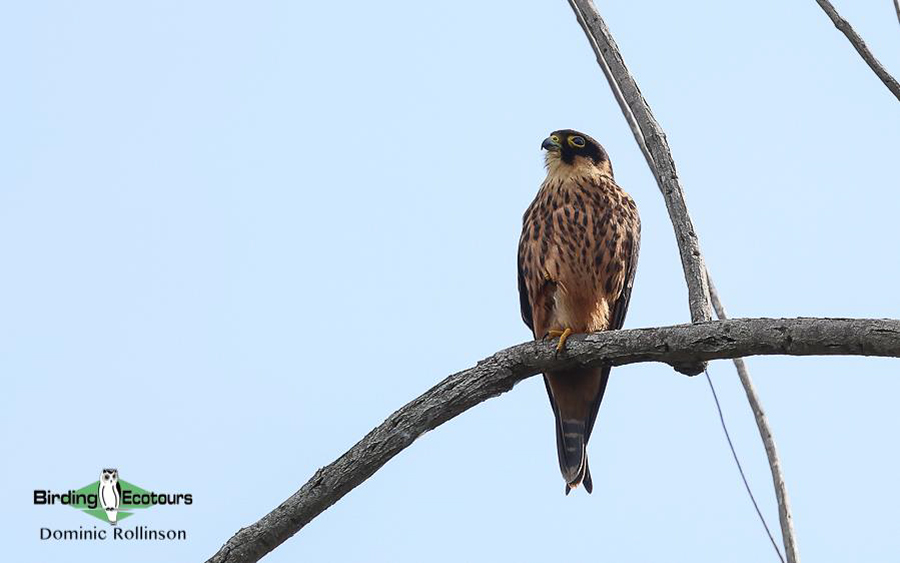
Entebbe must be one of the best places to find African Hobby.
Bird List – Following IOC (12.1)
Birds ‘heard only’ are marked with (H) after the common name, birds seen by the guide only are marked with a (G) after the common name, all other species were seen both by clients and guide.
The following notation after species names is used to show conservation status following BirdLife International. CR = Critically Endangered, EN = Endangered, VU = Vulnerable.
Albertine Rift endemics are bolded.
| Common Name | Scientific Name |
| Ducks, Geese, Swans (Anatidae) | |
| White-faced Whistling Duck | Dendrocygna viduata |
| White-backed Duck | Thalassornis leuconotus |
| Knob-billed Duck | Sarkidiornis melanotos |
| Egyptian Goose | Alopochen aegyptiaca |
| African Black Duck | Anas sparsa |
| Yellow-billed Duck | Anas undulata |
| Guineafowl (Numididae) | |
| Helmeted Guineafowl | Numida meleagris |
| Crested Guineafowl | Guttera pucherani |
| Pheasants & Allies (Phasianidae) | |
| Crested Francolin | Ortygornis sephaena |
| Coqui Francolin (H) | Campocolinus coqui |
| Handsome Spurfowl (H) | Pternistis nobilis |
| Heuglin’s Spurfowl (H) | Pternistis icterorhynchus |
| Red-necked Spurfowl | Pternistis afer |
| Nightjars (Caprimulgidae) | |
| Black-shouldered Nightjar | Caprimulgus nigriscapularis |
| Montane Nightjar (G) | Caprimulgus poliocephalus |
| Swamp Nightjar | Caprimulgus natalensis |
| Freckled Nightjar (H) | Caprimulgus tristigma |
| Square-tailed Nightjar (H) | Caprimulgus fossii |
| Pennant-winged Nightjar | Caprimulgus vexillarius |
| Swifts (Apodidae) | |
| Scarce Swift | Schoutedenapus myoptilus |
| Sabine’s Spinetail | Rhaphidura sabini |
| African Palm Swift | Cypsiurus parvus |
| Common Swift | Apus apus |
| Little Swift | Apus affinis |
| White-rumped Swift | Apus caffer |
| Turacos (Musophagidae) | |
| Great Blue Turaco | Corythaeola cristata |
| Bare-faced Go-away-bird | Crinifer personatus |
| Eastern Plantain-eater | Crinifer zonurus |
| Rwenzori Turaco | Gallirex johnstoni |
| Ross’s Turaco | Tauraco rossae |
| White-crested Turaco | Tauraco leucolophus |
| Black-billed Turaco | Tauraco schuettii |
| Cuckoos (Cuculidae) | |
| Senegal Coucal | Centropus senegalensis |
| Blue-headed Coucal | Centropus monachus |
| White-browed Coucal | Centropus superciliosus |
| Blue Malkoha | Ceuthmochares aereus |
| Levaillant’s Cuckoo | Clamator levaillantii |
| Jacobin Cuckoo | Clamator jacobinus |
| Diederik Cuckoo | Chrysococcyx caprius |
| Klaas’s Cuckoo | Chrysococcyx klaas |
| African Emerald Cuckoo | Chrysococcyx cupreus |
| Dusky Long-tailed Cuckoo | Cercococcyx mechowi |
| Barred Long-tailed Cuckoo | Cercococcyx montanus |
| Red-chested Cuckoo | Cuculus solitarius |
| Pigeons, Doves (Columbidae) | |
| Rock Dove | Columba livia |
| Speckled Pigeon | Columba guinea |
| Afep Pigeon | Columba unicincta |
| African Olive Pigeon | Columba arquatrix |
| Dusky Turtle Dove | Streptopelia lugens |
| Mourning Collared Dove | Streptopelia decipiens |
| Red-eyed Dove | Streptopelia semitorquata |
| Ring-necked Dove | Streptopelia capicola |
| Vinaceous Dove | Streptopelia vinacea |
| Laughing Dove | Spilopelia senegalensis |
| Emerald-spotted Wood Dove | Turtur chalcospilos |
| Black-billed Wood Dove | Turtur abyssinicus |
| Blue-spotted Wood Dove | Turtur afer |
| Tambourine Dove | Turtur tympanistria |
| Bruce’s Green Pigeon (G) | Treron waalia |
| African Green Pigeon | Treron calvus |
| Finfoots (Heliornithidae) | |
| African Finfoot | Podica senegalensis |
| Flufftails (Sarothruridae) | |
| White-spotted Flufftail | Sarothrura pulchra |
| Red-chested Flufftail (H) | Sarothrura rufa |
| Rails, Crakes & Coots (Rallidae) | |
| African Rail | Rallus caerulescens |
| African Crake | Crecopsis egregia |
| Common Moorhen | Gallinula chloropus |
| Red-knobbed Coot | Fulica cristata |
| African Swamphen | Porphyrio madagascariensis |
| Black Crake | Zapornia flavirostra |
| Cranes (Gruidae) | |
| Grey Crowned Crane – EN | Balearica regulorum |
| Grebes (Podicipedidae) | |
| Little Grebe | Tachybaptus ruficollis |
| Flamingos (Phoenicopteridae) | |
| Lesser Flamingo | Phoeniconaias minor |
| Buttonquail (Turnicidae) | |
| Common Buttonquail | Turnix sylvaticus |
| Stone-curlews, Thick-knees (Burhinidae) | |
| Senegal Thick-knee | Burhinus senegalensis |
| Water Thick-knee | Burhinus vermiculatus |
| Stilts, Avocets (Recurvirostridae) | |
| Black-winged Stilt | Himantopus himantopus |
| Plovers (Charadriidae) | |
| Long-toed Lapwing | Vanellus crassirostris |
| Spur-winged Lapwing | Vanellus spinosus |
| Black-headed Lapwing | Vanellus tectus |
| Senegal Lapwing | Vanellus lugubris |
| Crowned Lapwing | Vanellus coronatus |
| African Wattled Lapwing | Vanellus senegallus |
| Brown-chested Lapwing | Vanellus superciliosus |
| Kittlitz’s Plover | Charadrius pecuarius |
| Jacanas (Jacanidae) | |
| African Jacana | Actophilornis africanus |
| Sandpipers, Snipes (Scolopacidae) | |
| Common Sandpiper | Actitis hypoleucos |
| Wood Sandpiper | Tringa glareola |
| Common Greenshank | Tringa nebularia |
| Coursers, Pratincoles (Glareolidae) | |
| Rock Pratincole | Glareola nuchalis |
| Gulls, Terns, Skimmers (Laridae) | |
| Grey-headed Gull | Chroicocephalus cirrocephalus |
| White-winged Tern | Chlidonias leucopterus |
| Storks (Ciconiidae) | |
| Yellow-billed Stork | Mycteria ibis |
| African Openbill | Anastomus lamelligerus |
| Woolly-necked Stork | Ciconia episcopus |
| Saddle-billed Stork | Ephippiorhynchus senegalensis |
| Marabou Stork | Leptoptilos crumenifer |
| Anhingas, Darters (Anhingidae) | |
| African Darter | Anhinga rufa |
| Cormorants, Shags (Phalacrocoracidae) | |
| Reed Cormorant | Microcarbo africanus |
| White-breasted Cormorant | Phalacrocorax lucidus |
| Ibises, Spoonbills (Threskiornithidae) | |
| African Sacred Ibis | Threskiornis aethiopicus |
| Hadada Ibis | Bostrychia hagedash |
| Glossy Ibis | Plegadis falcinellus |
| African Spoonbill | Platalea alba |
| Herons, Bitterns (Ardeidae) | |
| Little Bittern | Ixobrychus minutus |
| Dwarf Bittern | Ixobrychus sturmii |
| White-backed Night Heron | Gorsachius leuconotus |
| Striated Heron | Butorides striata |
| Squacco Heron | Ardeola ralloides |
| Rufous-bellied Heron | Ardeola rufiventris |
| Western Cattle Egret | Bubulcus ibis |
| Grey Heron | Ardea cinerea |
| Black-headed Heron | Ardea melanocephala |
| Goliath Heron | Ardea goliath |
| Purple Heron | Ardea purpurea |
| Great Egret | Ardea alba |
| Intermediate Egret | Ardea intermedia |
| Little Egret | Egretta garzetta |
| Hamerkop (Scopidae) | |
| Hamerkop | Scopus umbretta |
| Shoebill (Balaenicipitidae) | |
| Shoebill – VU | Balaeniceps rex |
| Pelicans (Pelecanidae) | |
| Great White Pelican | Pelecanus onocrotalus |
| Pink-backed Pelican | Pelecanus rufescens |
| Ospreys (Pandionidae) | |
| Western Osprey | Pandion haliaetus |
| Kites, Hawks, Eagles (Accipitridae) | |
| Black-winged Kite | Elanus caeruleus |
| African Harrier-Hawk | Polyboroides typus |
| Palm-nut Vulture | Gypohierax angolensis |
| European Honey Buzzard | Pernis apivorus |
| African Cuckoo-Hawk | Aviceda cuculoides |
| Hooded Vulture – CR | Necrosyrtes monachus |
| White-backed Vulture – CR | Gyps africanus |
| Rüppell’s Vulture – CR | Gyps rueppelli |
| Lappet-faced Vulture – EN | Torgos tracheliotos |
| Black-chested Snake Eagle | Circaetus pectoralis |
| Brown Snake Eagle | Circaetus cinereus |
| Western Banded Snake Eagle | Circaetus cinerascens |
| Bateleur – EN | Terathopius ecaudatus |
| Bat Hawk | Macheiramphus alcinus |
| Crowned Eagle (H) | Stephanoaetus coronatus |
| Martial Eagle – EN | Polemaetus bellicosus |
| Long-crested Eagle | Lophaetus occipitalis |
| Wahlberg’s Eagle | Hieraaetus wahlbergi |
| Ayres’s Hawk-Eagle | Hieraaetus ayresii |
| Cassin’s Hawk-Eagle | Aquila africana |
| African Hawk-Eagle | Aquila spilogaster |
| Lizard Buzzard | Kaupifalco monogrammicus |
| Dark Chanting Goshawk | Melierax metabates |
| African Goshawk | Accipiter tachiro |
| Shikra | Accipiter badius |
| Rufous-breasted Sparrowhawk | Accipiter rufiventris |
| Black Sparrowhawk | Accipiter melanoleucus |
| African Marsh Harrier | Circus ranivorus |
| Yellow-billed Kite | Milvus aegyptius |
| African Fish Eagle | Haliaeetus vocifer |
| Augur Buzzard | Buteo augur |
| Barn Owls (Tytonidae) | |
| Western Barn Owl | Tyto alba |
| Owls (Strigidae) | |
| Pearl-spotted Owlet | Glaucidium perlatum |
| African Scops Owl (H) | Otus senegalensis |
| Southern White-faced Owl | Ptilopsis granti |
| Verreaux’s Eagle-Owl | Bubo lacteus |
| African Wood Owl | Strix woodfordii |
| Mousebirds (Coliidae) | |
| Speckled Mousebird | Colius striatus |
| Blue-naped Mousebird | Urocolius macrourus |
| Trogons (Trogonidae) | |
| Narina Trogon (H) | Apaloderma narina |
| Bar-tailed Trogon | Apaloderma vittatum |
| Hoopoes (Upupidae) | |
| African Hoopoe | Upupa africana |
| Wood Hoopoes (Phoeniculidae) | |
| White-headed Wood Hoopoe | Phoeniculus bollei |
| Green Wood Hoopoe | Phoeniculus purpureus |
| Common Scimitarbill | Rhinopomastus cyanomelas |
| Ground Hornbills (Bucorvidae) | |
| Abyssinian Ground Hornbill – VU | Bucorvus abyssinicus |
| Hornbills (Bucerotidae) | |
| Crowned Hornbill | Lophoceros alboterminatus |
| African Pied Hornbill | Lophoceros fasciatus |
| African Grey Hornbill | Lophoceros nasutus |
| White-thighed Hornbill | Bycanistes albotibialis |
| Black-and-white-casqued Hornbill | Bycanistes subcylindricus |
| Rollers (Coraciidae) | |
| Lilac-breasted Roller | Coracias caudatus |
| Blue-throated Roller (G) | Eurystomus gularis |
| Broad-billed Roller | Eurystomus glaucurus |
| Kingfishers (Alcedinidae) | |
| Chocolate-backed Kingfisher | Halcyon badia |
| Grey-headed Kingfisher | Halcyon leucocephala |
| Striped Kingfisher | Halcyon chelicuti |
| Blue-breasted Kingfisher | Halcyon malimbica |
| Woodland Kingfisher | Halcyon senegalensis |
| African Dwarf Kingfisher | Ispidina lecontei |
| African Pygmy Kingfisher | Ispidina picta |
| Malachite Kingfisher | Corythornis cristatus |
| Shining-blue Kingfisher (G) | Alcedo quadribrachys |
| Giant Kingfisher | Megaceryle maxima |
| Pied Kingfisher | Ceryle rudis |
| Bee-eaters (Meropidae) | |
| Black Bee-eater | Merops gularis |
| Swallow-tailed Bee-eater | Merops hirundineus |
| Little Bee-eater | Merops pusillus |
| Blue-breasted Bee-eater | Merops variegatus |
| Cinnamon-chested Bee-eater | Merops oreobates |
| Red-throated Bee-eater | Merops bulocki |
| Olive Bee-eater | Merops superciliosus |
| Northern Carmine Bee-eater | Merops nubicus |
| African Barbets (Lybiidae) | |
| Grey-throated Barbet | Gymnobucco bonapartei |
| Speckled Tinkerbird | Pogoniulus scolopaceus |
| Western Tinkerbird | Pogoniulus coryphaea |
| Yellow-throated Tinkerbird | Pogoniulus subsulphureus |
| Yellow-rumped Tinkerbird | Pogoniulus bilineatus |
| Yellow-fronted Tinkerbird | Pogoniulus chrysoconus |
| Yellow-spotted Barbet | Buccanodon duchaillui |
| Hairy-breasted Barbet | Tricholaema hirsuta |
| Spot-flanked Barbet | Tricholaema lacrymosa |
| White-headed Barbet | Lybius leucocephalus |
| Red-faced Barbet | Lybius rubrifacies |
| Black-billed Barbet | Lybius guifsobalito |
| Black-collared Barbet | Lybius torquatus |
| Double-toothed Barbet | Lybius bidentatus |
| Yellow-billed Barbet | Trachyphonus purpuratus |
| Crested Barbet | Trachyphonus vaillantii |
| Honeyguides (Indicatoridae) | |
| Cassin’s Honeybird | Prodotiscus insignis |
| Dwarf Honeyguide | Indicator pumilio |
| Willcocks’s Honeyguide | Indicator willcocksi |
| Lesser Honeyguide | Indicator minor |
| Woodpeckers (Picidae) | |
| Red-throated Wryneck | Jynx ruficollis |
| Buff-spotted Woodpecker | Pardipicus nivosus |
| Brown-eared Woodpecker (H) | Pardipicus caroli |
| Nubian Woodpecker | Campethera nubica |
| Little Spotted Woodpecker | Campethera cailliautii |
| Yellow-crested Woodpecker | Chloropicus xantholophus |
| Speckle-breasted Woodpecker | Dendropicos poecilolaemus |
| Cardinal Woodpecker | Dendropicos fuscescens |
| Elliot’s Woodpecker | Dendropicos elliotii |
| African Grey Woodpecker | Dendropicos goertae |
| Caracaras, Falcons (Falconidae) | |
| Grey Kestrel | Falco ardosiaceus |
| Red-necked Falcon | Falco chicquera |
| African Hobby | Falco cuvierii |
| Lanner Falcon | Falco biarmicus |
| African & New World Parrots (Psittacidae) | |
| Grey Parrot – EN | Psittacus erithacus |
| Meyer’s Parrot | Poicephalus meyeri |
| Old World Parrots (Psittaculidae) | |
| Red-headed Lovebird | Agapornis pullarius |
| African & Green Broadbills (Calyptomenidae) | |
| African Broadbill | Smithornis capensis |
| Pittas (Pittidae) | |
| Green-breasted Pitta | Pitta reichenowi |
| Wattle-eyes, Batises (Platysteiridae) | |
| Rwenzori Batis | Batis diops |
| Chinspot Batis | Batis molitor |
| Western Black-headed Batis | Batis erlangeri |
| Ituri Batis (G) | Batis ituriensis |
| Chestnut Wattle-eye | Platysteira castanea |
| Brown-throated Wattle-eye | Platysteira cyanea |
| Jameson’s Wattle-eye | Platysteira jamesoni |
| Bushshrikes (Malaconotidae) | |
| Grey-headed Bushshrike | Malaconotus blanchoti |
| Many-colored Bushshrike | Chlorophoneus multicolor |
| Bocage’s Bushshrike | Chlorophoneus bocagei |
| Orange-breasted Bushshrike | Chlorophoneus sulfureopectus |
| Doherty’s Bushshrike | Telophorus dohertyi |
| Marsh Tchagra | Bocagia minuta |
| Brown-crowned Tchagra | Tchagra australis |
| Black-crowned Tchagra | Tchagra senegalus |
| Pink-footed Puffback | Dryoscopus angolensis |
| Northern Puffback | Dryoscopus gambensis |
| Albertine Sooty Boubou | Laniarius holomelas |
| Slate-colored Boubou | Laniarius funebris |
| Lühder’s Bushshrike | Laniarius luehderi |
| Tropical Boubou | Laniarius major |
| Papyrus Gonolek | Laniarius mufumbiri |
| Black-headed Gonolek | Laniarius erythrogaster |
| Brubru | Nilaus afer |
| Vangas & Allies (Vangidae) | |
| White-crested Helmetshrike | Prionops plumatus |
| African Shrike-flycatcher | Megabyas flammulatus |
| Black-and-white Shrike-flycatcher | Bias musicus |
| Cuckooshrikes (Campephagidae) | |
| Grey Cuckooshrike | Ceblepyris caesius |
| Black Cuckooshrike | Campephaga flava |
| Red-shouldered Cuckooshrike (G) | Campephaga phoenicea |
| Petit’s Cuckooshrike | Campephaga petiti |
| Shrikes (Laniidae) | |
| Mackinnon’s Shrike | Lanius mackinnoni |
| Grey-backed Fiscal | Lanius excubitoroides |
| Northern Fiscal | Lanius humeralis |
| Figbirds, Orioles, Turnagra (Oriolidae) | |
| Western Oriole | Oriolus brachyrynchus |
| Black-headed Oriole | Oriolus larvatus |
| Mountain Oriole | Oriolus percivali |
| African Golden Oriole | Oriolus auratus |
| Drongos (Dicruridae) | |
| Fork-tailed Drongo | Dicrurus adsimilis |
| Monarchs (Monarchidae) | |
| Red-bellied Paradise Flycatcher | Terpsiphone rufiventer |
| African Paradise Flycatcher | Terpsiphone viridis |
| Crows, Jays (Corvidae) | |
| Piapiac | Ptilostomus afer |
| Pied Crow | Corvus albus |
| White-necked Raven | Corvus albicollis |
| Fairy Flycatchers (Stenostiridae) | |
| African Blue Flycatcher | Elminia longicauda |
| White-tailed Blue Flycatcher | Elminia albicauda |
| White-tailed Crested Flycatcher | Elminia albonotata |
| Tits, Chickadees (Paridae) | |
| White-shouldered Black Tit | Melaniparus guineensis |
| White-winged Black Tit | Melaniparus leucomelas |
| Dusky Tit | Melaniparus funereus |
| Stripe-breasted Tit | Melaniparus fasciiventer |
| Penduline Tits (Remizidae) | |
| Grey Penduline Tit | Anthoscopus caroli |
| Nicators (Nicatoridae) | |
| Western Nicator | Nicator chloris |
| Larks (Alaudidae) | |
| Rufous-naped Lark | Mirafra africana |
| Flappet Lark | Mirafra rufocinnamomea |
| White-tailed Lark | Mirafra albicauda |
| Red-capped Lark | Calandrella cinerea |
| Bulbuls (Pycnonotidae) | |
| Slender-billed Greenbul | Stelgidillas gracilirostris |
| Red-tailed Bristlebill | Bleda syndactylus |
| Yellow-throated Leaflove | Atimastillas flavicollis |
| Spotted Greenbul | Ixonotus guttatus |
| Honeyguide Greenbul | Baeopogon indicator |
| Kakamega Greenbul (G) | Arizelocichla kakamegae |
| Olive-breasted Greenbul | Arizelocichla kikuyuensis |
| Red-tailed Greenbul | Criniger calurus |
| Little Greenbul | Eurillas virens |
| Yellow-whiskered Greenbul | Eurillas latirostris |
| Plain Greenbul | Eurillas curvirostris |
| Little Grey Greenbul | Eurillas gracilis |
| Ansorge’s Greenbul | Eurillas ansorgei |
| Yellow-streaked Greenbul | Phyllastrephus flavostriatus |
| Toro Olive Greenbul | Phyllastrephus hypochloris |
| Dark-capped Bulbul | Pycnonotus tricolor |
| Swallows, Martins (Hirundinidae) | |
| Black Saw-wing | Psalidoprocne pristoptera |
| White-headed Saw-wing | Psalidoprocne albiceps |
| Banded Martin | Neophedina cincta |
| Brown-throated Martin | Riparia paludicola |
| Rock Martin | Ptyonoprogne fuligula |
| Wire-tailed Swallow | Hirundo smithii |
| Barn Swallow | Hirundo rustica |
| Angolan Swallow | Hirundo angolensis |
| Red-breasted Swallow | Cecropis semirufa |
| Mosque Swallow | Cecropis senegalensis |
| Lesser Striped Swallow | Cecropis abyssinica |
| Red-rumped Swallow | Cecropis daurica |
| Crombecs, African Warblers (Macrosphenidae) | |
| Moustached Grass Warbler | Melocichla mentalis |
| Grey Longbill | Macrosphenus concolor |
| Northern Crombec | Sylvietta brachyura |
| Red-faced Crombec | Sylvietta whytii |
| Green Crombec | Sylvietta virens |
| White-browed Crombec | Sylvietta leucophrys |
| Cettia Bush Warblers & Allies (Cettiidae) | |
| Neumann’s Warbler (H) | Urosphena neumanni |
| Yellow Flycatchers (Erythrocercidae) | |
| Chestnut-capped Flycatcher | Erythrocercus mccallii |
| Hylias (Hyliidae) | |
| Green Hylia | Hylia prasina |
| Leaf Warblers & Allies (Phylloscopidae) | |
| Red-faced Woodland Warbler | Phylloscopus laetus |
| Uganda Woodland Warbler (H) | Phylloscopus budongoensis |
| Reed Warblers & Allies (Acrocephalidae) | |
| Grauer’s Warbler | Graueria vittata |
| Greater Swamp Warbler | Acrocephalus rufescens |
| Mountain Yellow Warbler | Iduna similis |
| Papyrus Yellow Warbler – VU | Calamonastides gracilirostris |
| Grassbirds & Allies (Locustellidae) | |
| Fan-tailed Grassbird (H) | Catriscus brevirostris |
| Cinnamon Bracken Warbler | Bradypterus cinnamomeus |
| White-winged Swamp Warbler | Bradypterus carpalis |
| Highland Rush Warbler | Bradypterus centralis |
| Cisticolas & Allies (Cisticolidae) | |
| Red-faced Cisticola | Cisticola erythrops |
| Singing Cisticola | Cisticola cantans |
| Whistling Cisticola | Cisticola lateralis |
| Trilling Cisticola | Cisticola woosnami |
| Chubb’s Cisticola | Cisticola chubbi |
| Rattling Cisticola | Cisticola chiniana |
| Winding Cisticola | Cisticola marginatus |
| Carruthers’s Cisticola | Cisticola carruthersi |
| Stout Cisticola | Cisticola robustus |
| Croaking Cisticola | Cisticola natalensis |
| Short-winged Cisticola | Cisticola brachypterus |
| Foxy Cisticola | Cisticola troglodytes |
| Long-tailed Cisticola | Cisticola angusticauda |
| Zitting Cisticola | Cisticola juncidis |
| Tawny-flanked Prinia | Prinia subflava |
| Black-faced Prinia | Prinia melanops |
| White-chinned Prinia | Schistolais leucopogon |
| Rwenzori Apalis | Oreolais ruwenzorii |
| Red-winged Grey Warbler | Drymocichla incana |
| Buff-bellied Warbler | Phyllolais pulchella |
| Yellow-breasted Apalis | Apalis flavida |
| Lowland Masked Apalis | Apalis binotata |
| Mountain Masked Apalis | Apalis personata |
| Black-throated Apalis | Apalis jacksoni |
| Chestnut-throated Apalis | Apalis porphyrolaema |
| Buff-throated Apalis | Apalis rufogularis |
| Grey Apalis | Apalis cinerea |
| Grey-capped Warbler | Eminia lepida |
| Grey-backed Camaroptera | Camaroptera brevicaudata |
| Olive-green Camaroptera (H) | Camaroptera chloronota |
| Black-faced Rufous Warbler | Bathmocercus rufus |
| Green-backed Eremomela | Eremomela canescens |
| Green-capped Eremomela | Eremomela scotops |
| Rufous-crowned Eremomela (G) | Eremomela badiceps |
| Sylviid Babblers (Sylviidae) | |
| Rwenzori Hill Babbler | Sylvia atriceps |
| White-eyes (Zosteropidae) | |
| Green White-eye | Zosterops stuhlmanni |
| Northern Yellow White-eye | Zosterops senegalensis |
| Ground Babblers (Pellorneidae) | |
| Brown Illadopsis | Illadopsis fulvescens |
| Mountain Illadopsis | Illadopsis pyrrhoptera |
| Scaly-breasted Illadopsis (H) | Illadopsis albipectus |
| Laughingthrushes & Allies (Leiothrichidae) | |
| Brown Babbler (G) | Turdoides plebejus |
| Arrow-marked Babbler | Turdoides jardineii |
| Dusky Babbler | Turdoides tenebrosa |
| Black-lored Babbler | Turdoides sharpei |
| Starlings, Rhabdornis (Sturnidae) | |
| Wattled Starling | Creatophora cinerea |
| Purple-headed Starling | Hylopsar purpureiceps |
| Greater Blue-eared Starling | Lamprotornis chalybaeus |
| Lesser Blue-eared Starling | Lamprotornis chloropterus |
| Splendid Starling | Lamprotornis splendidus |
| Rüppell’s Starling | Lamprotornis purpuroptera |
| Violet-backed Starling | Cinnyricinclus leucogaster |
| Slender-billed Starling | Onychognathus tenuirostris |
| Waller’s Starling | Onychognathus walleri |
| Narrow-tailed Starling | Poeoptera lugubris |
| Sharpe’s Starling | Poeoptera sharpii |
| Oxpeckers (Buphagidae) | |
| Yellow-billed Oxpecker | Buphagus africanus |
| Thrushes (Turdidae) | |
| Fraser’s Rufous Thrush | Stizorhina fraseri |
| White-tailed Ant Thrush (H) | Neocossyphus poensis |
| African Thrush | Turdus pelios |
| Abyssinian Thrush | Turdus abyssinicus |
| Chats, Old World Flycatchers (Muscicapidae) | |
| Brown-backed Scrub Robin | Cercotrichas hartlaubi |
| White-browed Scrub Robin | Cercotrichas leucophrys |
| Fraser’s Forest Flycatcher | Fraseria ocreata |
| Grey-throated Tit-Flycatcher | Myioparus griseigularis |
| Grey Tit-Flycatcher | Myioparus plumbeus |
| White-eyed Slaty Flycatcher | Melaenornis fischeri |
| Northern Black Flycatcher | Melaenornis edolioides |
| Pale Flycatcher | Melaenornis pallidus |
| Silverbird | Empidornis semipartitus |
| Ashy Flycatcher | Muscicapa caerulescens |
| Swamp Flycatcher | Muscicapa aquatica |
| Cassin’s Flycatcher | Muscicapa cassini |
| Chapin’s Flycatcher – VU | Muscicapa lendu |
| African Dusky Flycatcher | Muscicapa adusta |
| Dusky-blue Flycatcher | Muscicapa comitata |
| Sooty Flycatcher | Muscicapa infuscata |
| Red-throated Alethe (H) | Chamaetylas poliophrys |
| Archer’s Ground Robin | Cossypha archeri |
| Grey-winged Robin-Chat | Cossypha polioptera |
| Blue-shouldered Robin-Chat | Cossypha cyanocampter |
| White-browed Robin-Chat | Cossypha heuglini |
| Red-capped Robin-Chat (G) | Cossypha natalensis |
| Snowy-crowned Robin-Chat | Cossypha niveicapilla |
| White-starred Robin | Pogonocichla stellata |
| Forest Robin (G) | Stiphrornis erythrothorax |
| Equatorial Akalat | Sheppardia aequatorialis |
| Spotted Palm Thrush | Cichladusa guttata |
| African Stonechat | Saxicola torquatus |
| Sooty Chat | Myrmecocichla nigra |
| Sunbirds (Nectariniidae) | |
| Grey-headed Sunbird | Deleornis axillaris |
| Western Violet-backed Sunbird | Anthreptes longuemarei |
| Little Green Sunbird | Anthreptes seimundi |
| Grey-chinned Sunbird | Anthreptes tephrolaemus |
| Collared Sunbird | Hedydipna collaris |
| Green-headed Sunbird | Cyanomitra verticalis |
| Blue-throated Brown Sunbird | Cyanomitra cyanolaema |
| Blue-headed Sunbird | Cyanomitra alinae |
| Olive Sunbird | Cyanomitra olivacea |
| Green-throated Sunbird | Chalcomitra rubescens |
| Scarlet-chested Sunbird | Chalcomitra senegalensis |
| Bronzy Sunbird | Nectarinia kilimensis |
| Olive-bellied Sunbird | Cinnyris chloropygius |
| Rwenzori Double-collared Sunbird | Cinnyris stuhlmanni |
| Northern Double-collared Sunbird | Cinnyris reichenowi |
| Regal Sunbird | Cinnyris regius |
| Beautiful Sunbird | Cinnyris pulchellus |
| Marico Sunbird | Cinnyris mariquensis |
| Red-chested Sunbird | Cinnyris erythrocercus |
| Purple-banded Sunbird | Cinnyris bifasciatus |
| Superb Sunbird | Cinnyris superbus |
| Variable Sunbird | Cinnyris venustus |
| Copper Sunbird | Cinnyris cupreus |
| Old World Sparrows, Snowfinches (Passeridae) | |
| Shelley’s Sparrow | Passer shelleyi |
| Northern Grey-headed Sparrow | Passer griseus |
| House Sparrow | Passer domesticus |
| Weavers, Widowbirds (Ploceidae) | |
| White-browed Sparrow-Weaver | Plocepasser mahali |
| Chestnut-crowned Sparrow-Weaver | Plocepasser superciliosus |
| Speckle-fronted Weaver | Sporopipes frontalis |
| Thick-billed Weaver | Amblyospiza albifrons |
| Baglafecht Weaver | Ploceus baglafecht |
| Slender-billed Weaver | Ploceus pelzelni |
| Little Weaver | Ploceus luteolus |
| Spectacled Weaver | Ploceus ocularis |
| Black-necked Weaver | Ploceus nigricollis |
| Strange Weaver | Ploceus alienus |
| Black-billed Weaver | Ploceus melanogaster |
| Holub’s Golden Weaver | Ploceus xanthops |
| Orange Weaver | Ploceus aurantius |
| Northern Brown-throated Weaver | Ploceus castanops |
| Lesser Masked Weaver | Ploceus intermedius |
| Vitelline Masked Weaver | Ploceus vitellinus |
| Village Weaver | Ploceus cucullatus |
| Vieillot’s Black Weaver | Ploceus nigerrimus |
| Weyns’s Weaver | Ploceus weynsi |
| Black-headed Weaver | Ploceus melanocephalus |
| Golden-backed Weaver | Ploceus jacksoni |
| Yellow-mantled Weaver | Ploceus tricolor |
| Compact Weaver | Ploceus superciliosus |
| Brown-capped Weaver | Ploceus insignis |
| Red-headed Malimbe | Malimbus rubricollis |
| Red-headed Weaver | Anaplectes rubriceps |
| Red-headed Quelea | Quelea erythrops |
| Red-billed Quelea | Quelea quelea |
| Black Bishop | Euplectes gierowii |
| Black-winged Red Bishop | Euplectes hordeaceus |
| Southern Red Bishop | Euplectes orix |
| Northern Red Bishop | Euplectes franciscanus |
| Fan-tailed Widowbird | Euplectes axillaris |
| Yellow-mantled Widowbird | Euplectes macroura |
| Marsh Widowbird | Euplectes hartlaubi |
| White-winged Widowbird | Euplectes albonotatus |
| Red-collared Widowbird | Euplectes ardens |
| Waxbills, Munias & Allies (Estrildidae) | |
| Bronze Mannikin | Spermestes cucullata |
| Magpie Mannikin | Spermestes fringilloides |
| Black-and-white Mannikin | Spermestes bicolor |
| White-collared Oliveback | Nesocharis ansorgei |
| Dusky Crimsonwing | Cryptospiza jacksoni |
| Jameson’s Antpecker (H) | Parmoptila jamesoni |
| White-breasted Nigrita | Nigrita fusconotus |
| Grey-headed Nigrita | Nigrita canicapillus |
| Grey-headed Oliveback | Delacourella capistrata |
| Black-faced Waxbill | Brunhilda erythronotos |
| Black-crowned Waxbill | Estrilda nonnula |
| Kandt’s Waxbill | Estrilda kandti |
| Fawn-breasted Waxbill | Estrilda paludicola |
| Common Waxbill | Estrilda astrild |
| Black-rumped Waxbill | Estrilda troglodytes |
| Quailfinch | Ortygospiza atricollis |
| Cut-throat Finch | Amadina fasciata |
| Orange-breasted Waxbill | Amandava subflava |
| Red-cheeked Cordon-bleu | Uraeginthus bengalus |
| Red-headed Bluebill (H) | Spermophaga ruficapilla |
| Green-winged Pytilia | Pytilia melba |
| Dusky Twinspot | Euschistospiza cinereovinacea |
| Brown Twinspot | Clytospiza monteiri |
| Red-billed Firefinch | Lagonosticta senegala |
| African Firefinch | Lagonosticta rubricata |
| Black-bellied Firefinch | Lagonosticta rara |
| Bar-breasted Firefinch | Lagonosticta rufopicta |
| Indigobirds, Whydahs (Viduidae) | |
| Village Indigobird | Vidua chalybeata |
| Pin-tailed Whydah | Vidua macroura |
| Wagtails, Pipits (Motacillidae) | |
| Cape Wagtail | Motacilla capensis |
| Mountain Wagtail (H) | Motacilla clara |
| African Pied Wagtail | Motacilla aguimp |
| Yellow-throated Longclaw | Macronyx croceus |
| African Pipit | Anthus cinnamomeus |
| Plain-backed Pipit | Anthus leucophrys |
| Finches, Euphonias (Fringillidae) | |
| Western Citril | Crithagra frontalis |
| Papyrus Canary | Crithagra koliensis |
| Yellow-fronted Canary | Crithagra mozambica |
| Brimstone Canary | Crithagra sulphurata |
| Thick-billed Seedeater | Crithagra burtoni |
| Streaky Seedeater | Crithagra striolata |
| Yellow-crowned Canary | Serinus flavivertex |
| Buntings (Emberizidae) | |
| Cinnamon-breasted Bunting | Emberiza tahapisi |
| Golden-breasted Bunting | Emberiza flaviventris |
| Species Seen | 503 |
| Species heard only | 20 |
| Species seen by guide only | 11 |
| Total species recorded | 534 |
Mammal List
The following notation after species names is used to show conservation status following the IUCN Red List:
CR = Critically Endangered, EN = Endangered, VU = Vulnerable.
| Common Name | Scientific Name |
| Elephants (Elephantidae) | |
| African Elephant – VU | Loxodonta africana |
| Squirrels and Relatives (Sciuridae) | |
| Striped Ground Squirrel | Euxerus erythropus |
| Carruthers’s Mountain Squirrel | Funisciurus carruthersi |
| Boehm’s Bush Squirrel | Paraxerus boehmi |
| Old World Monkeys (Cercopithecidae) | |
| Grey-cheeked Mangabey – VU | Lophocebus albigena |
| Olive Baboon | Papio anubis |
| Patas Monkey | Erythrocebus patas |
| Vervet Monkey | Chlorocebus pygerythrus |
| L’Hoest’s Monkey – VU | Allochrocebus lhoesti |
| Red-tailed Monkey | Cercopithecus ascanius |
| Blue Monkey | Cercopithecus mitis |
| Guereza | Colobus guereza |
| Ashy Red Colobus – EN | Piliocolobus tephrosceles |
| Great Apes (Hominidae) | |
| Eastern Gorilla – CR | Gorilla beringei |
| Chimpanzee – EN | Pan troglodytes |
| Fruit Bats (Pteropodidae) | |
| Straw-colored Fruit Bat | Eidolon helvum |
| False Vampire Bats (Megadermatidae) | |
| Yellow-winged Bat | Lavia frons |
| Cats (Felidae) | |
| Lion | Panthera leo |
| Leopard | Panthera pardus |
| Mongooses and Fossa (Herpestidae) | |
| Common Dwarf Mongoose | Helogale parvula |
| Horses, Asses and Zebras (Equidae) | |
| Plains Zebra | Equus quagga |
| Rhinoceroses (Rhinocerotidae) | |
| White Rhinoceros | Ceratotherium simum |
| Hogs and Pigs (Suidae) | |
| Common Warthog | Phacochoerus africanus |
| Forest Hog | Hylochoerus meinertzhageni |
| Bush Pig | Potamochoerus larvatus |
| Hippopotamuses (Hippopotamidae) | |
| Hippopotamus – VU | Hippopotamus amphibius |
| Bovids (Bovidae) | |
| African Buffalo | Syncerus caffer |
| Bushbuck | Tragelaphus scriptus |
| Common Eland | Tragelaphus oryx |
| Impala | Aepyceros melampus |
| Oribi | Ourebia ourebi |
| (Defassa) Waterbuck | Kobus ellipsiprymnus |
| Kob | Kobus kob |
| (Lelwel) Hartebeest | Alcelaphus buselaphus |
| Topi | Damaliscus lunatus |
| Black-fronted Duiker | Cephalophus nigrifrons |
| Yellow-backed Duiker | Cephalophus silvicultor |
| Giraffes and Okapis (Giraffidae) | |
| Giraffe – VU | Giraffa camelopardalis |
| Species seen: | 38 |
This is a sample trip report. Please email us ([email protected]) for more trip reports from this destination.
